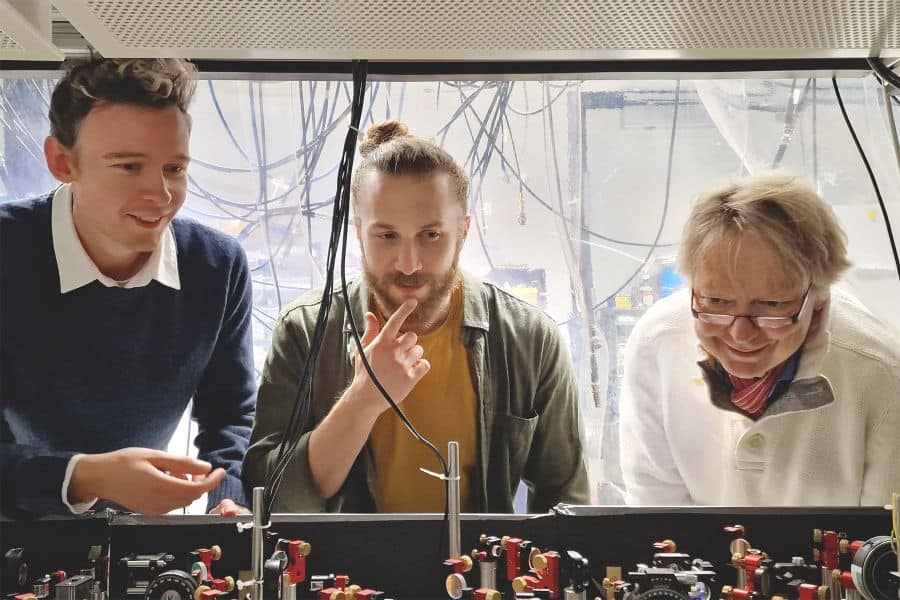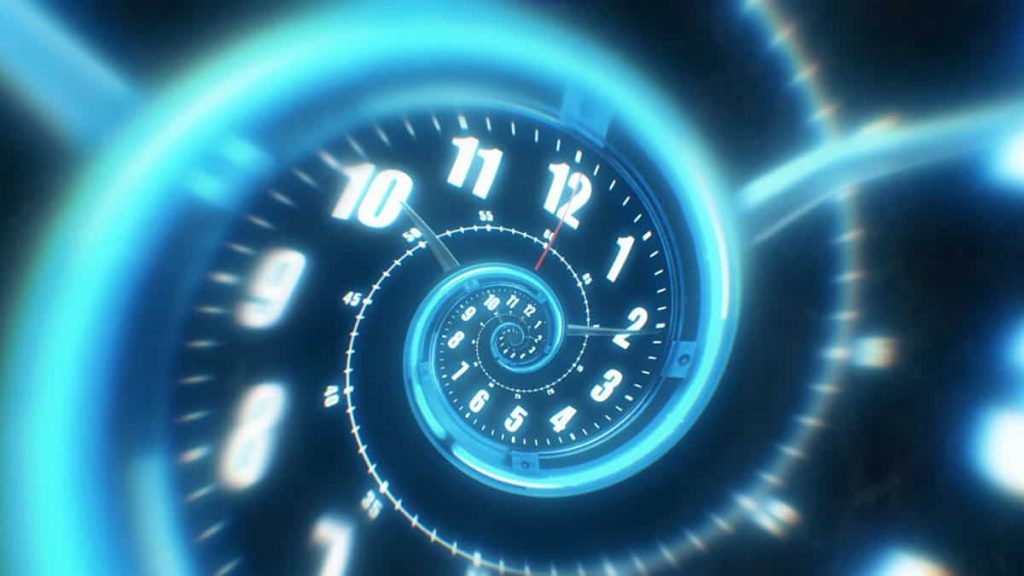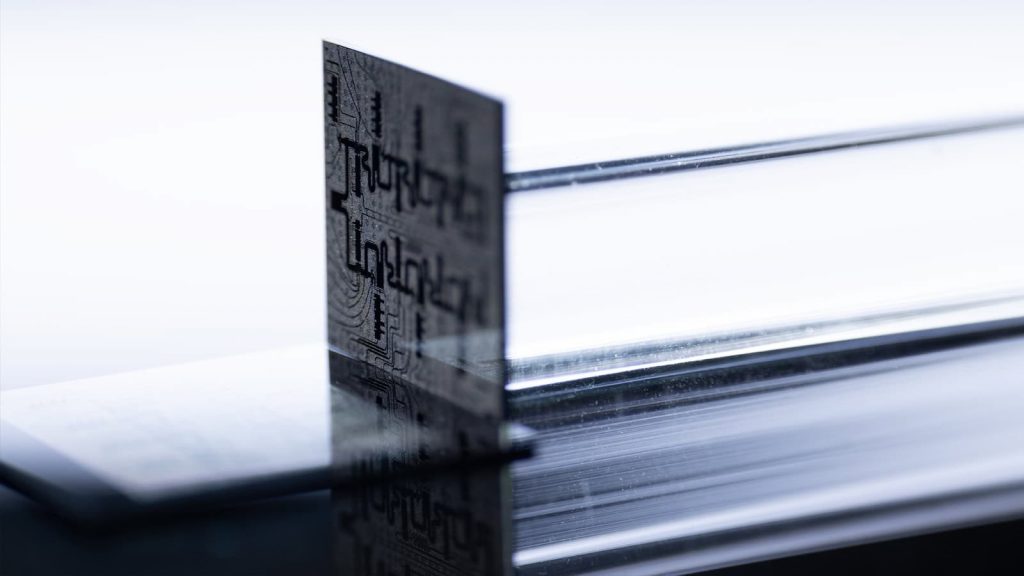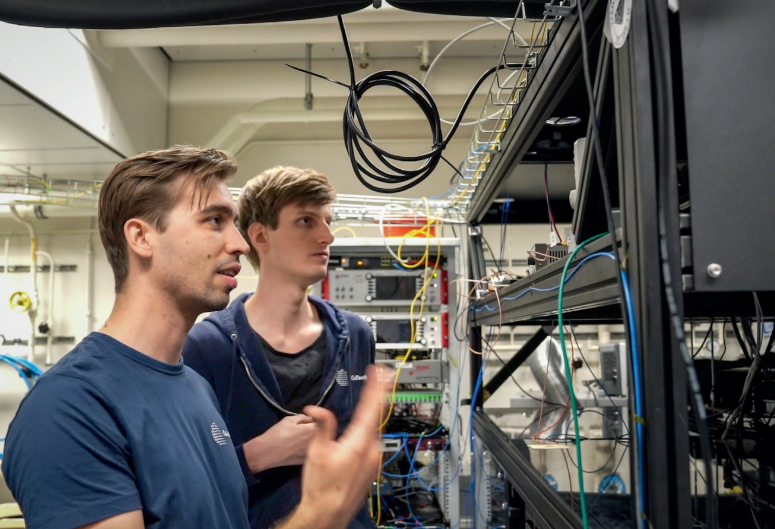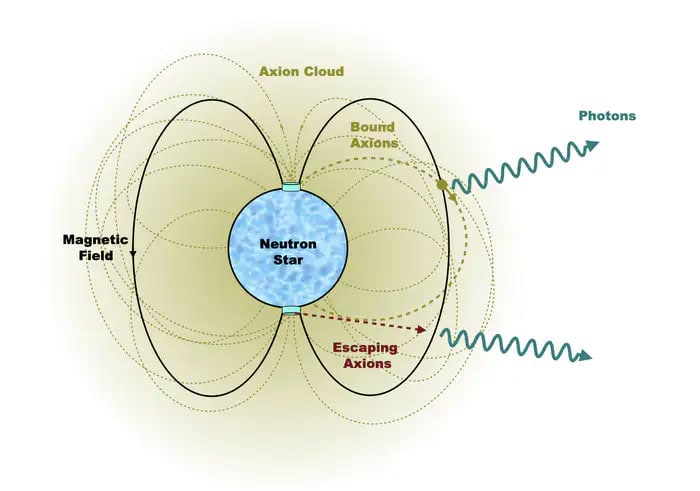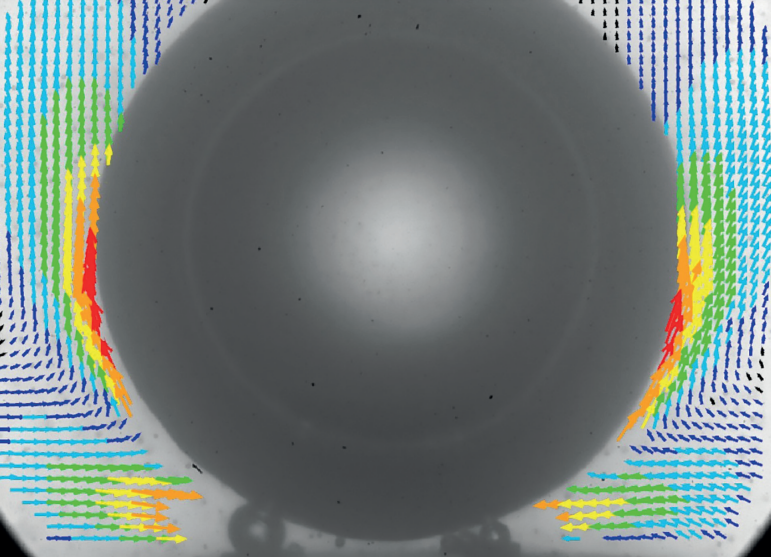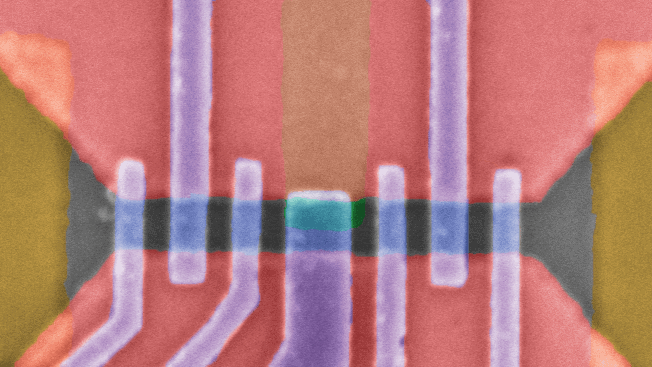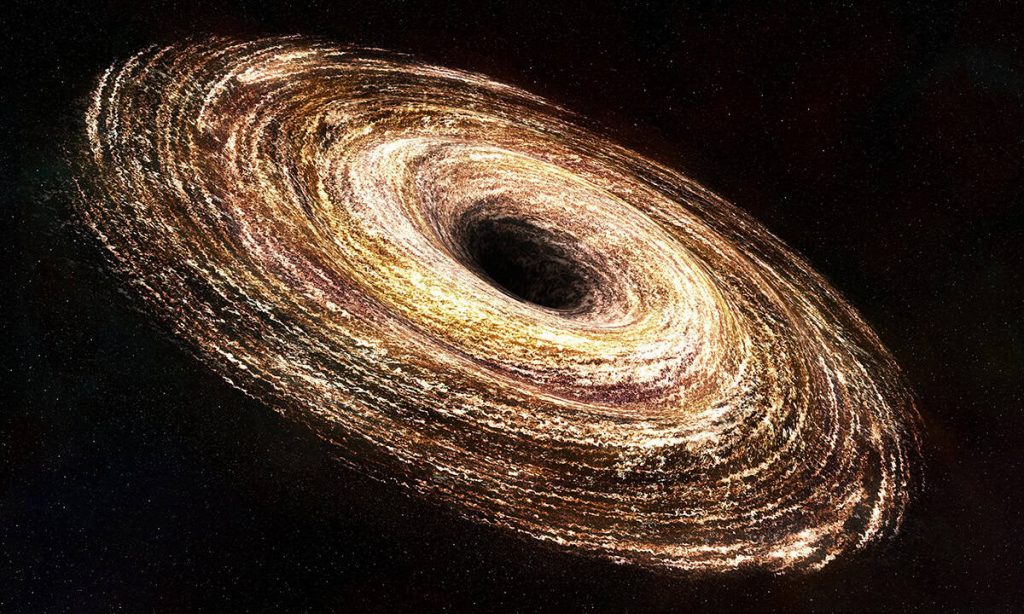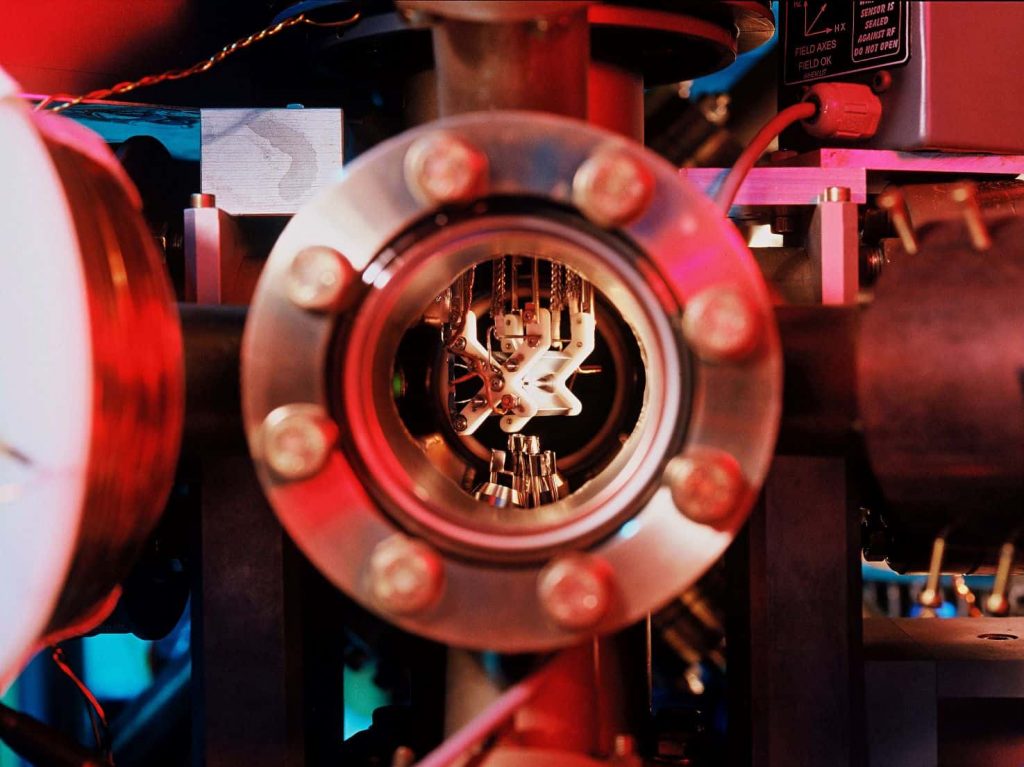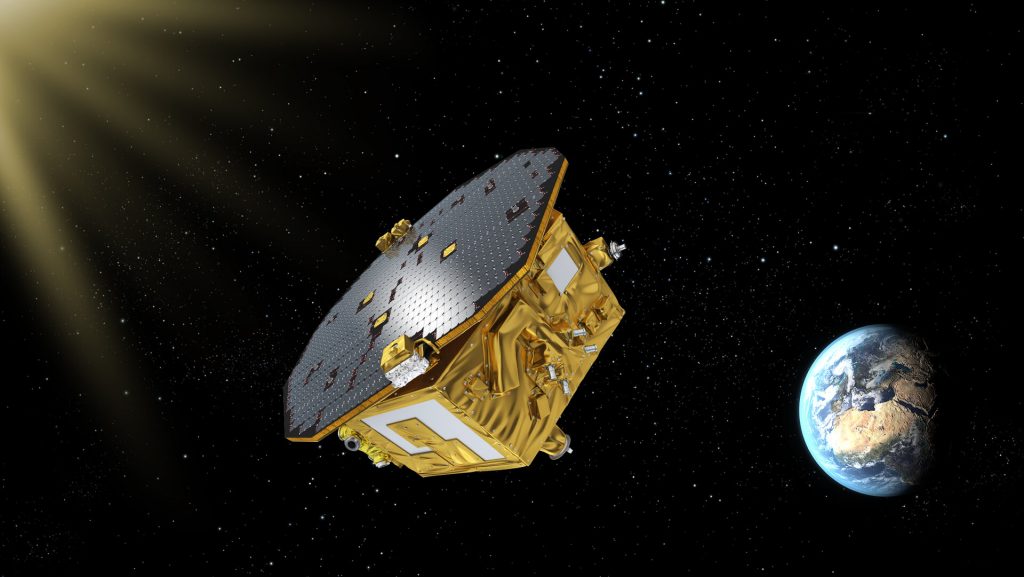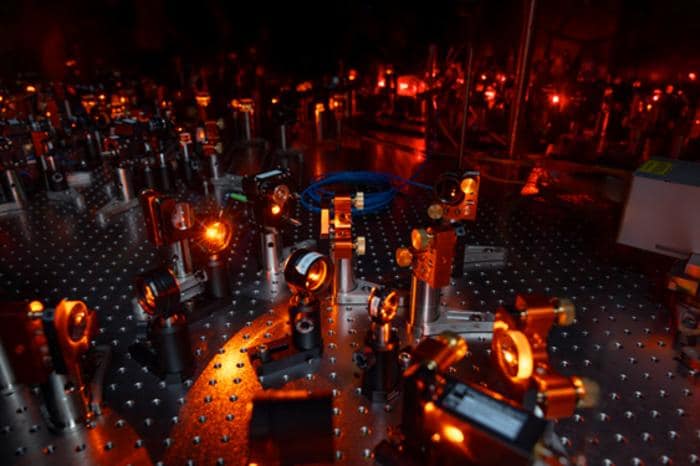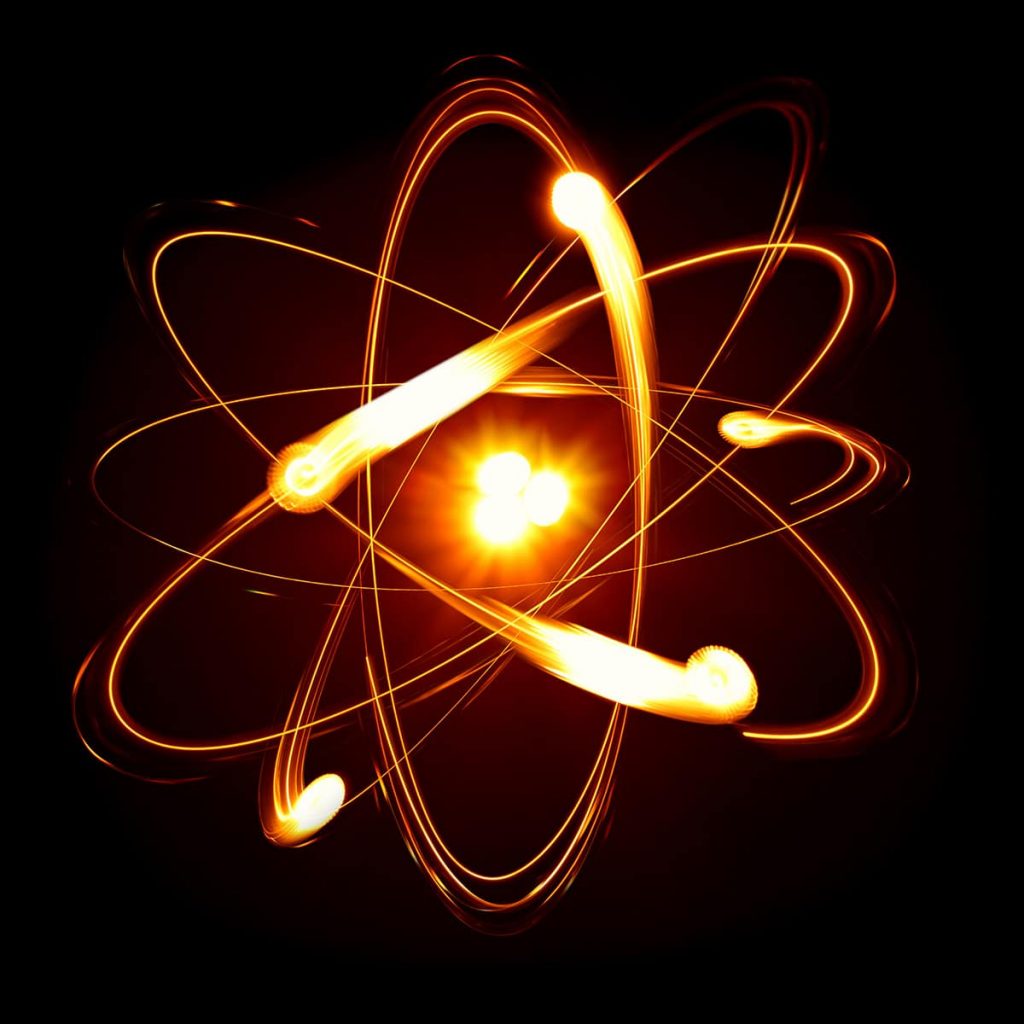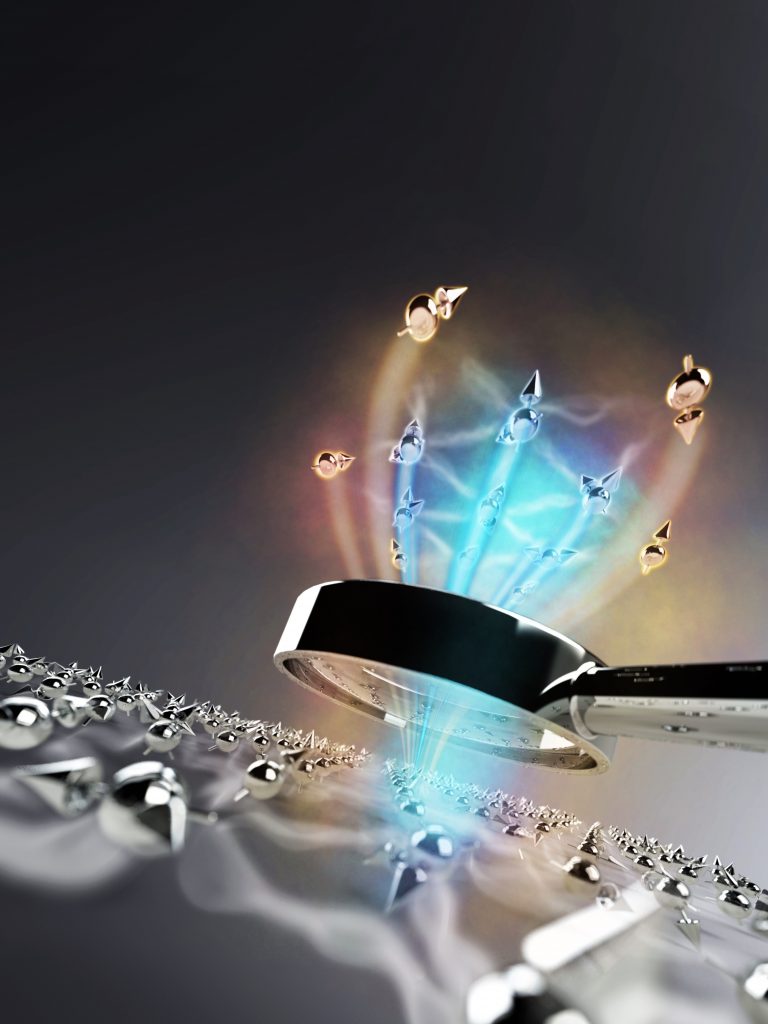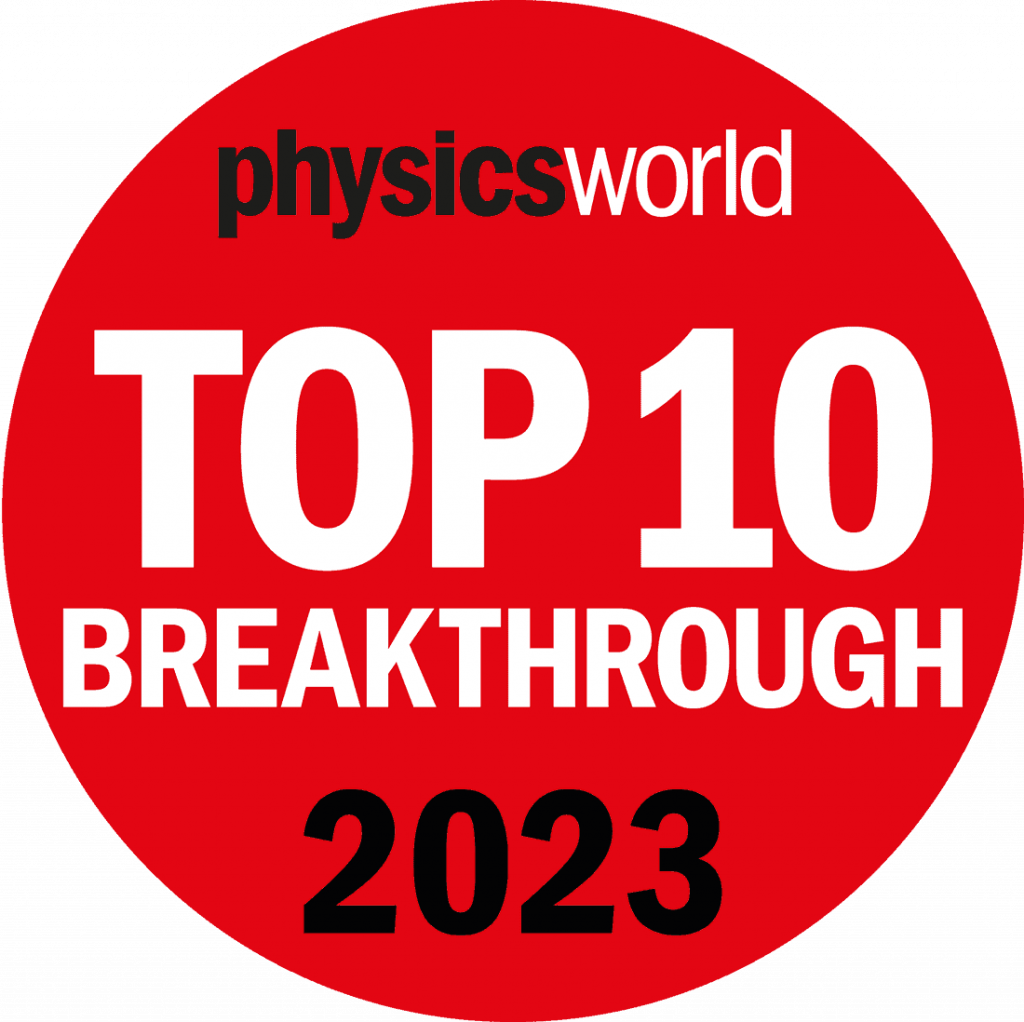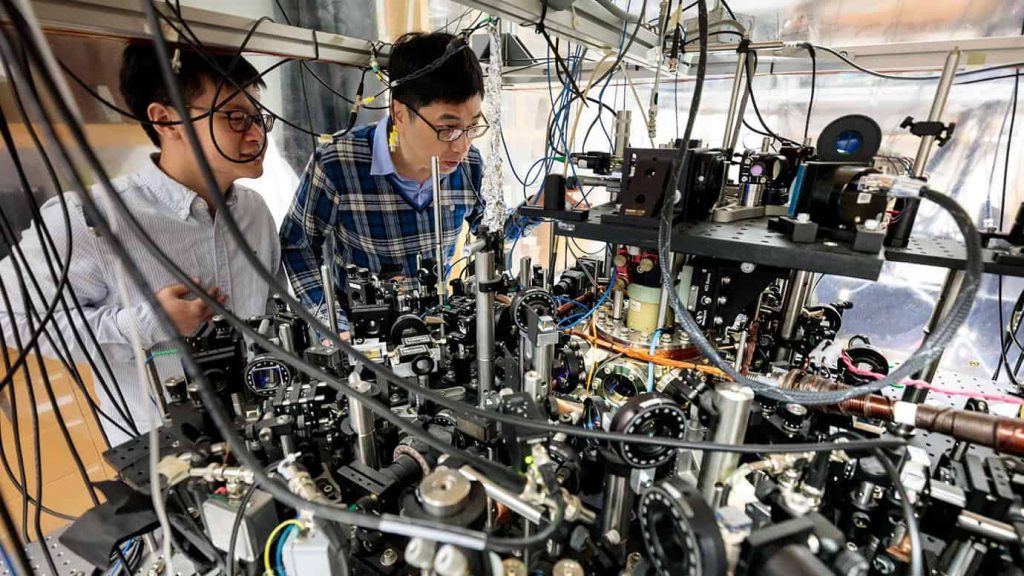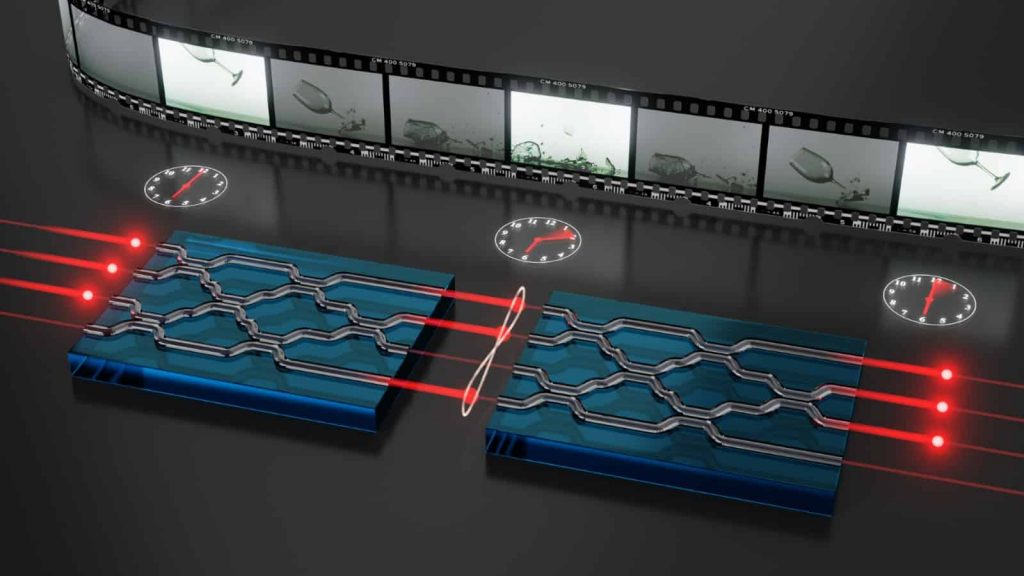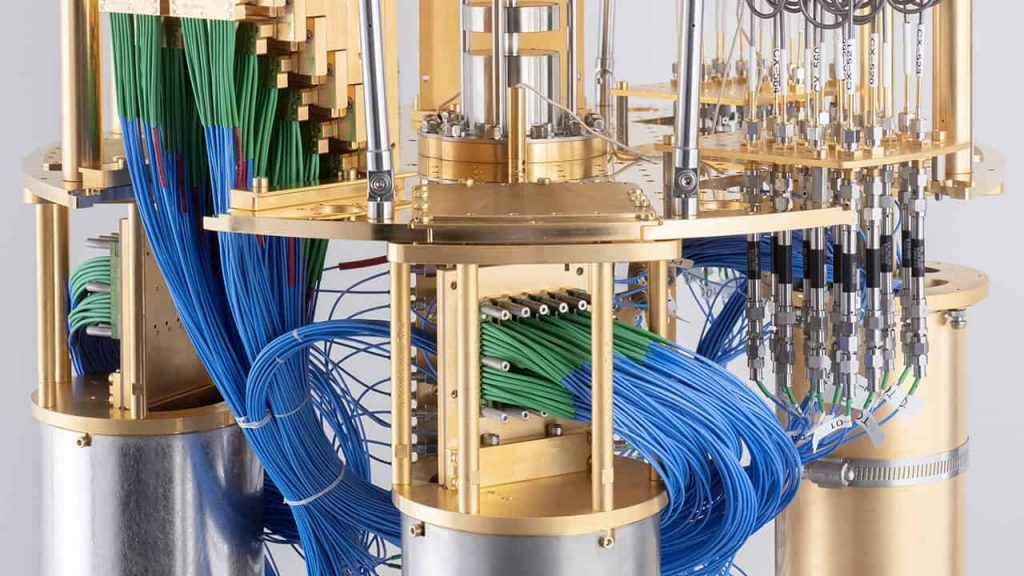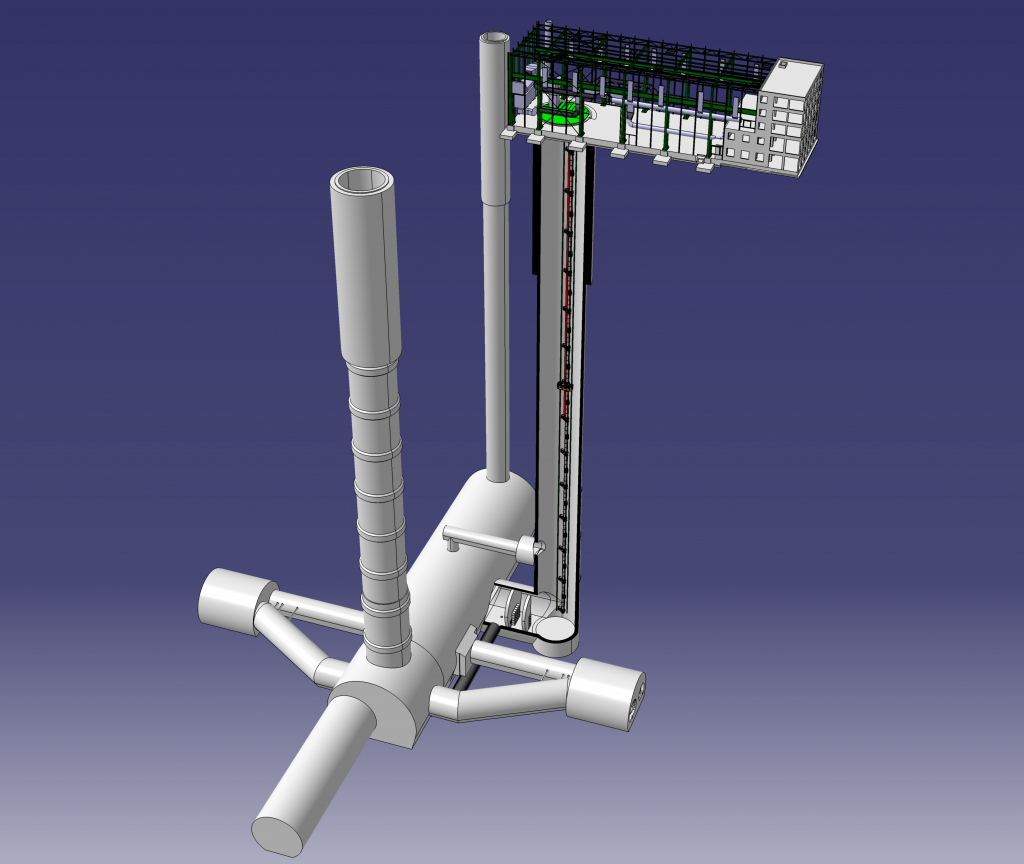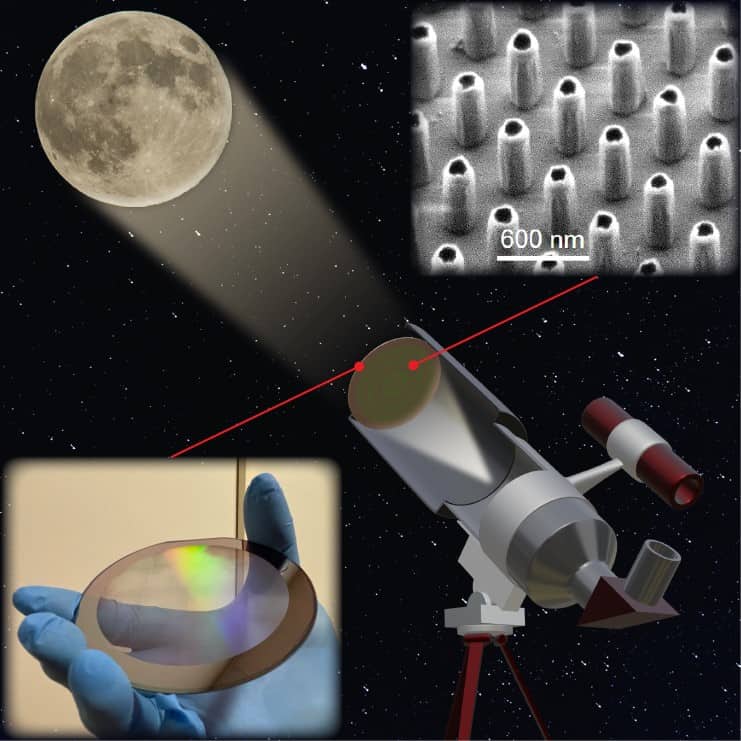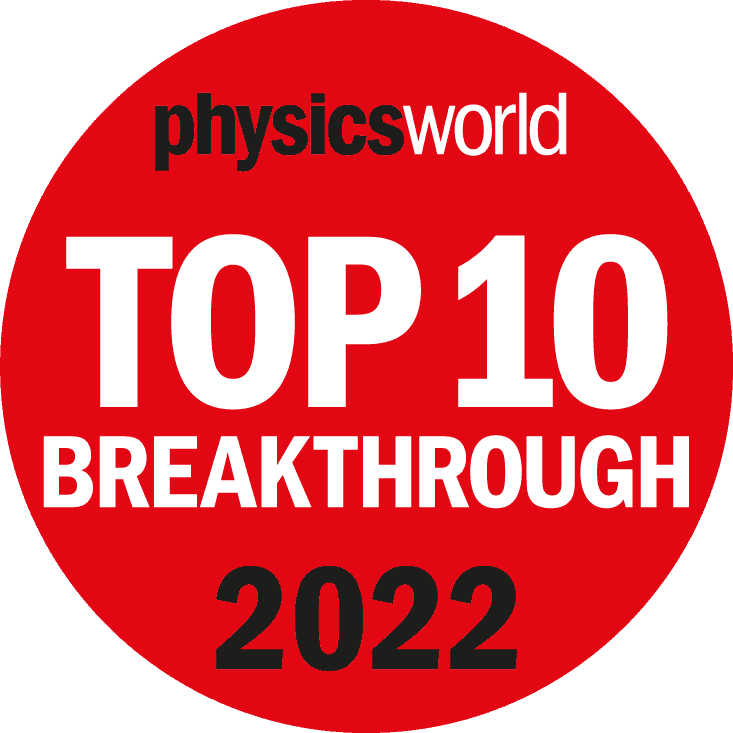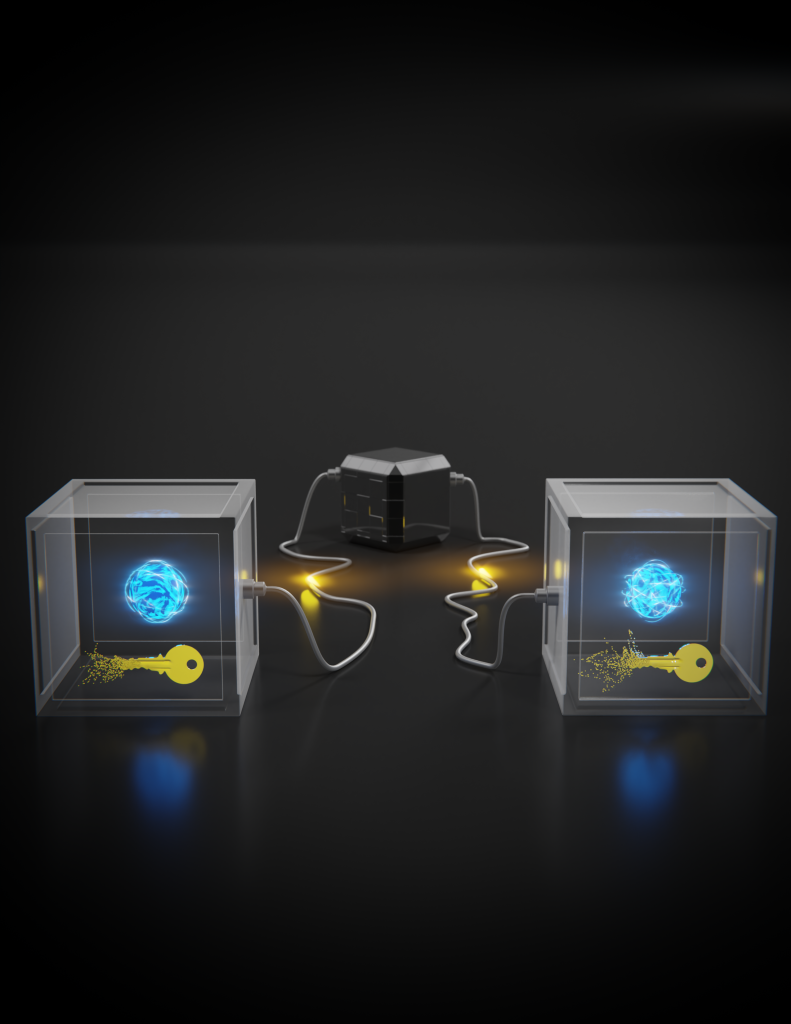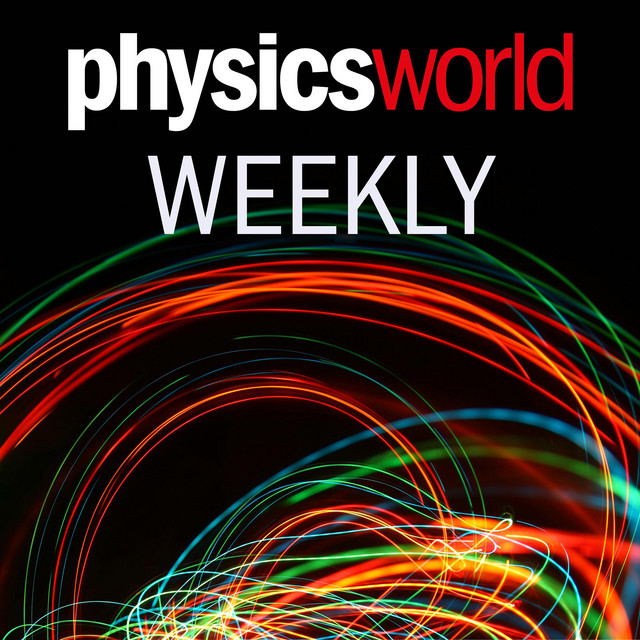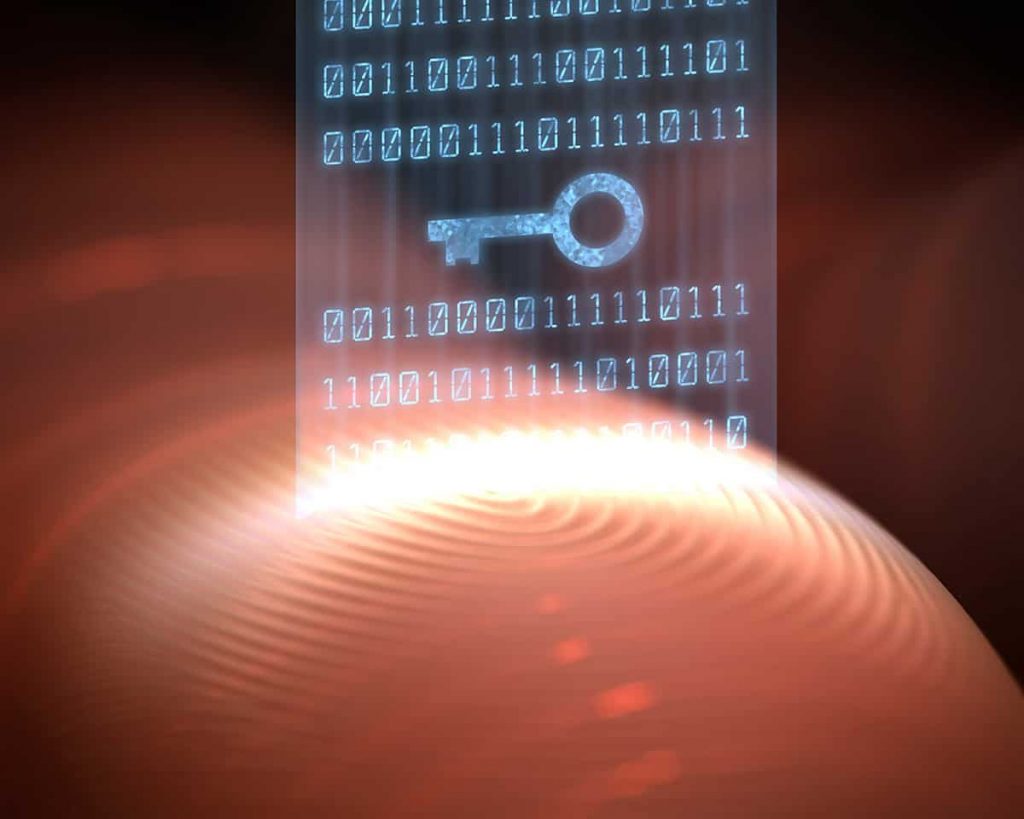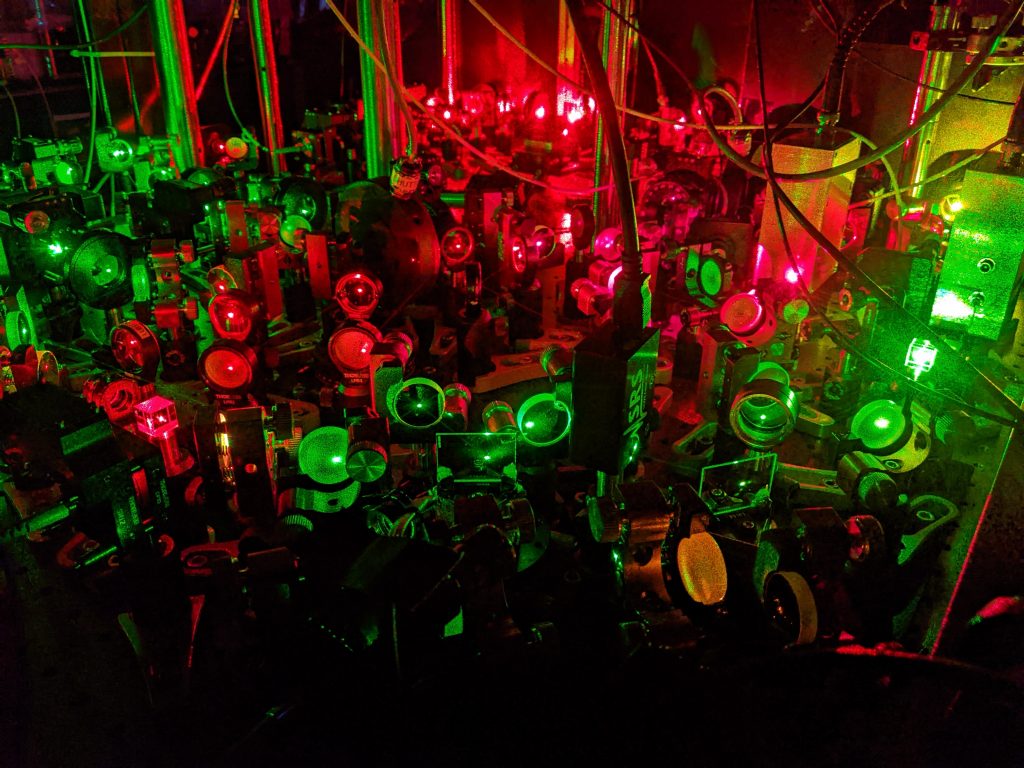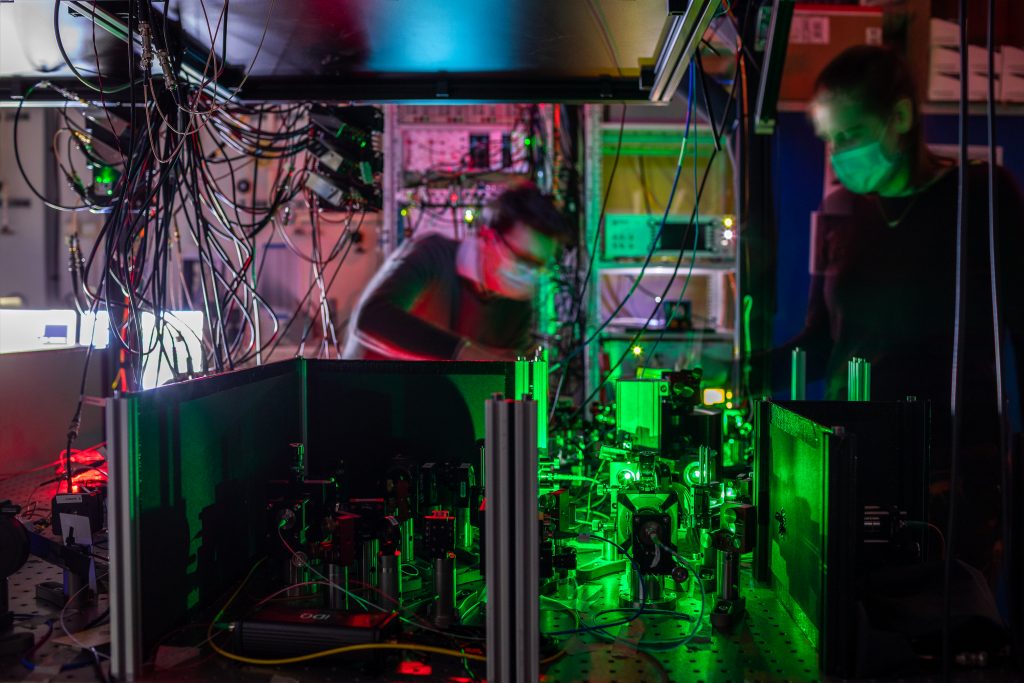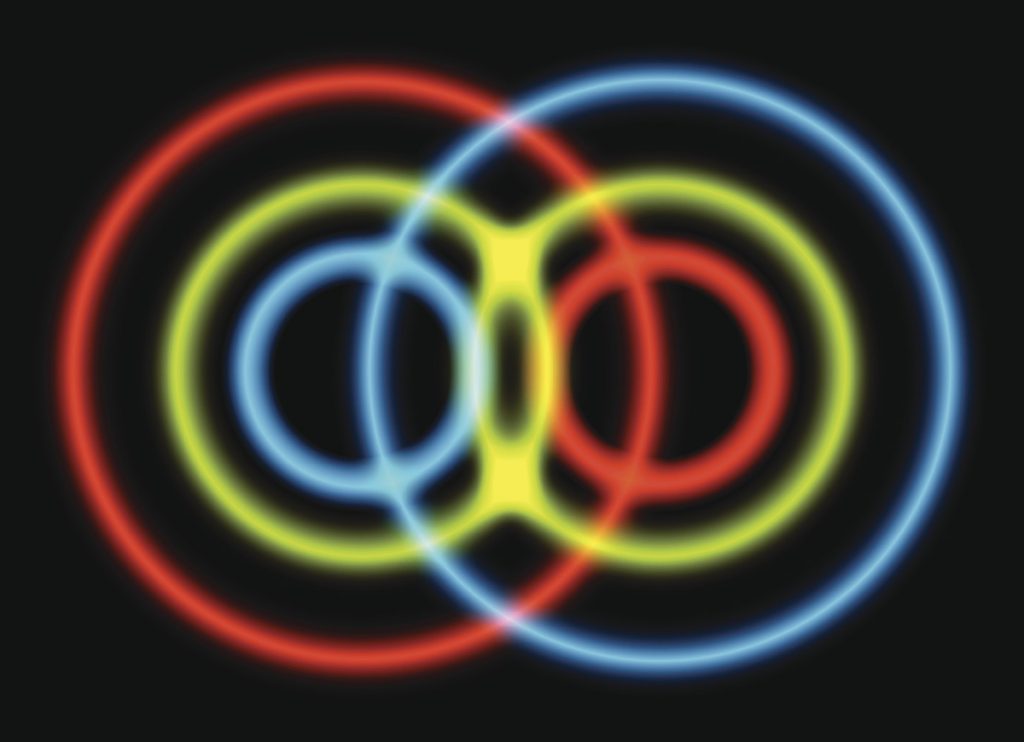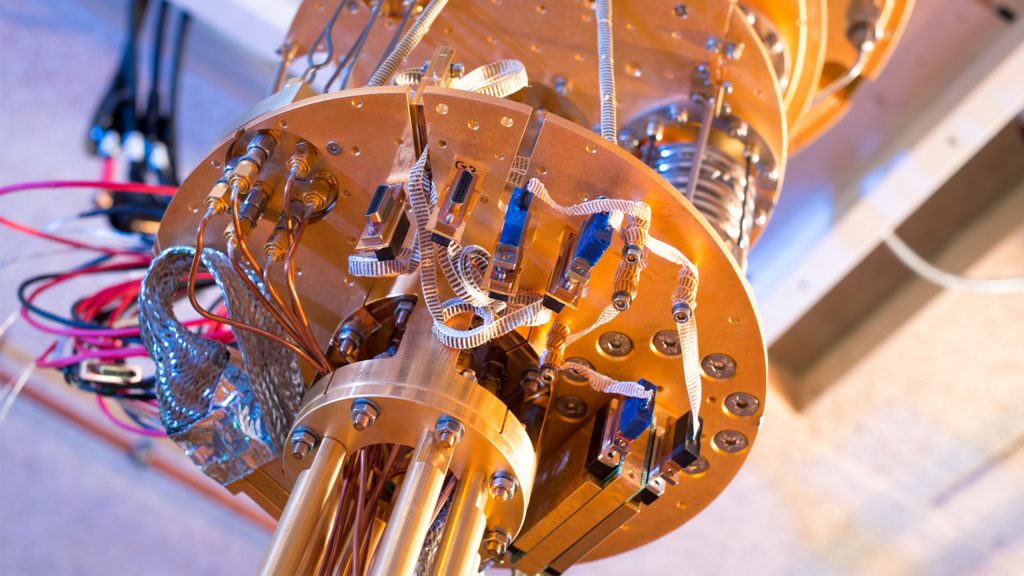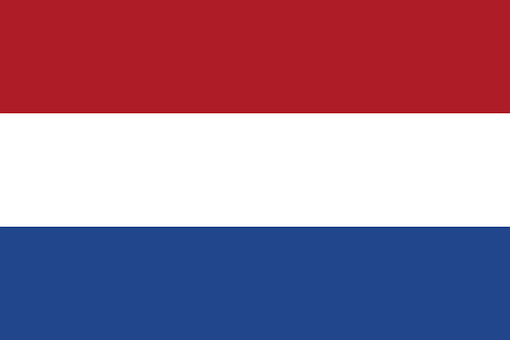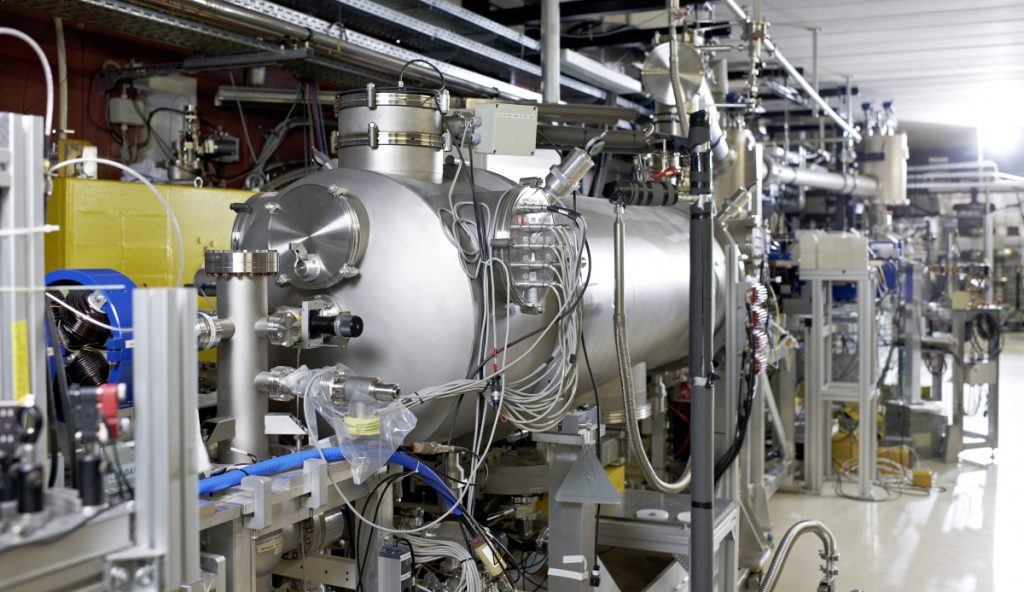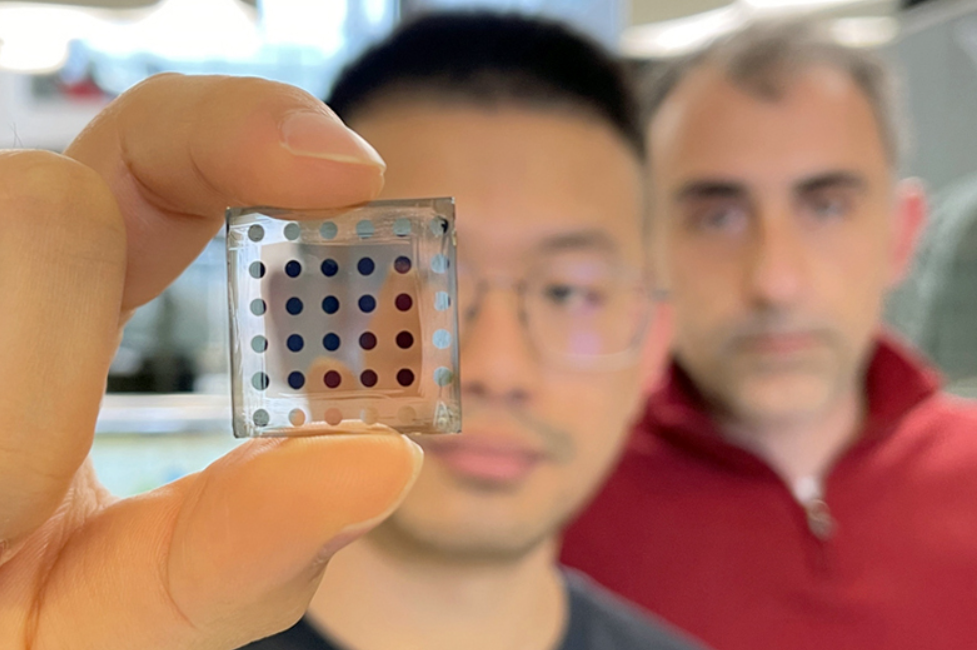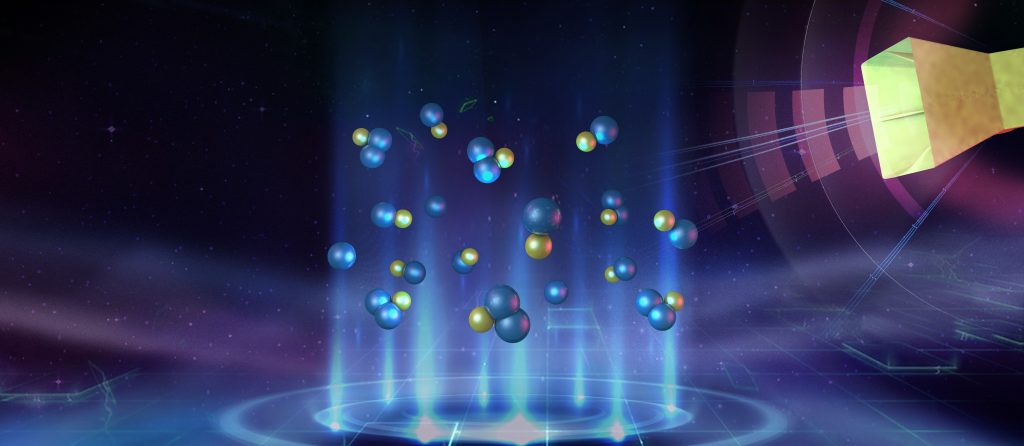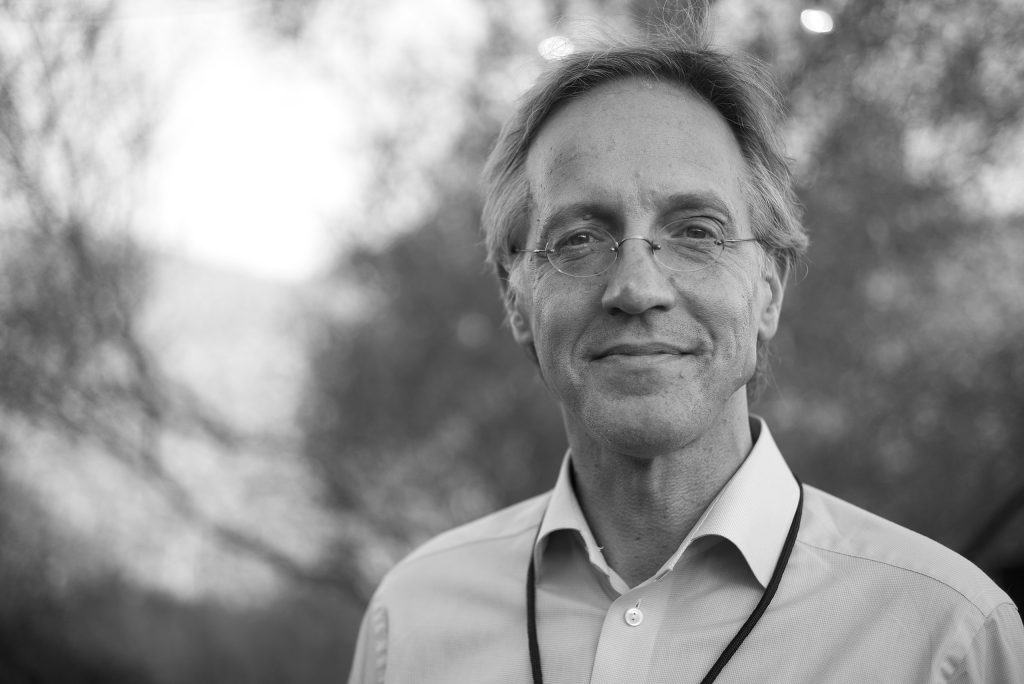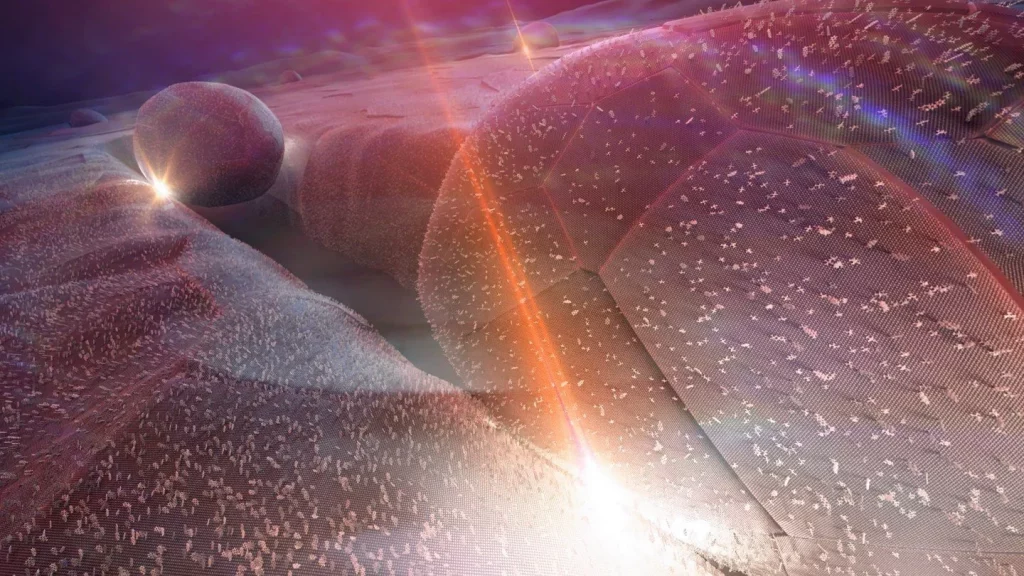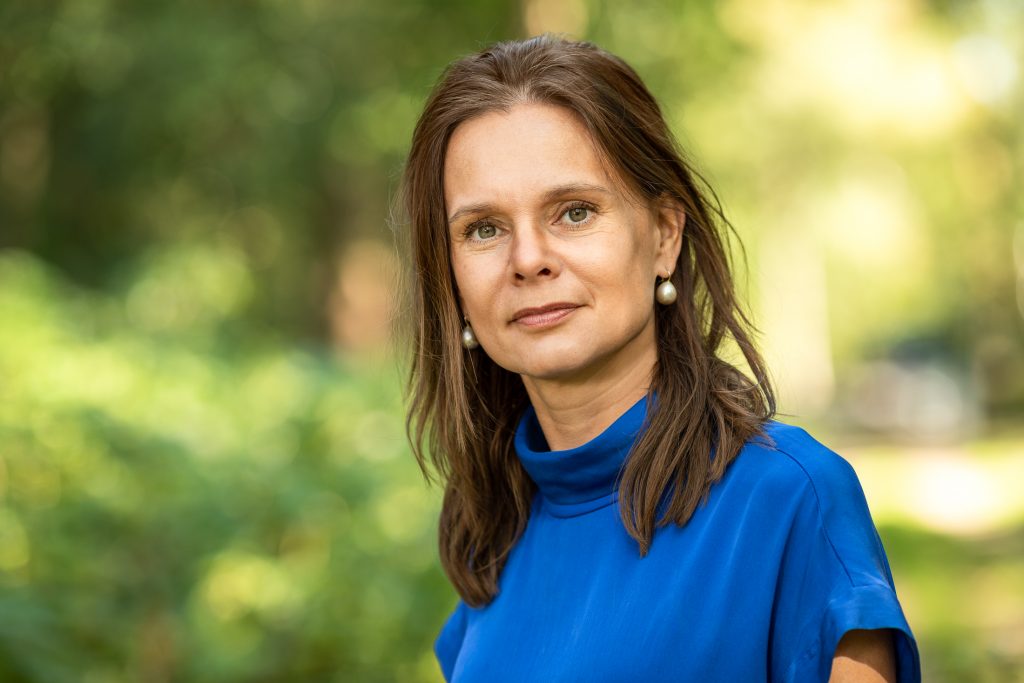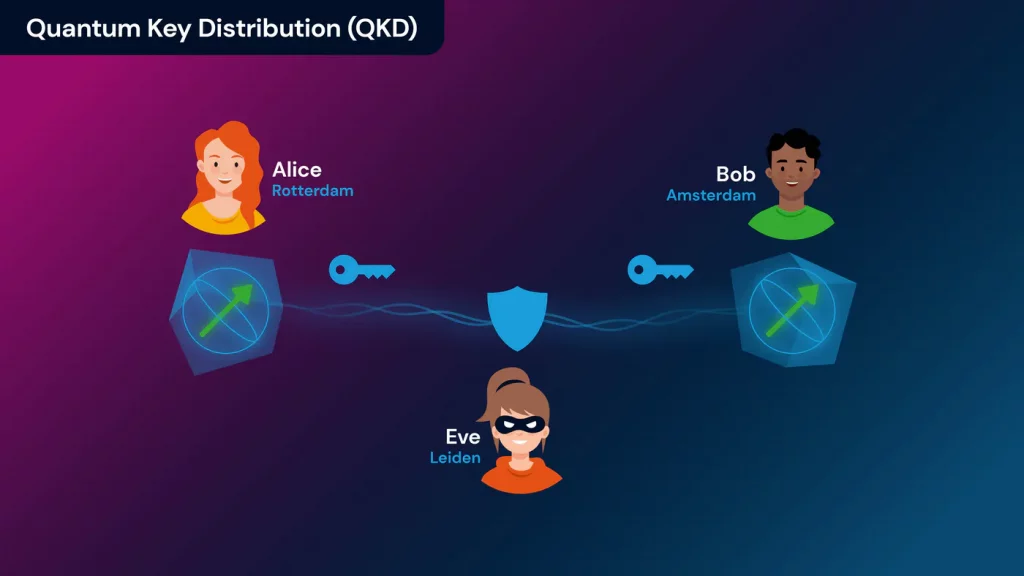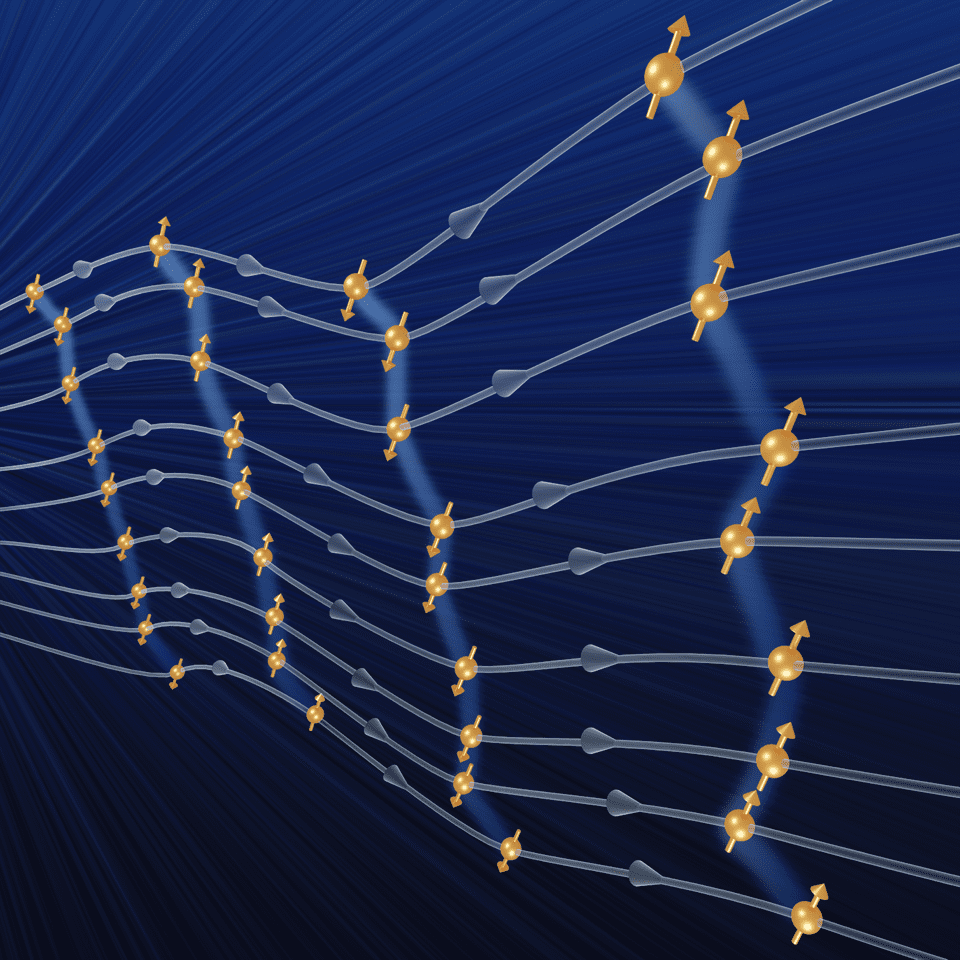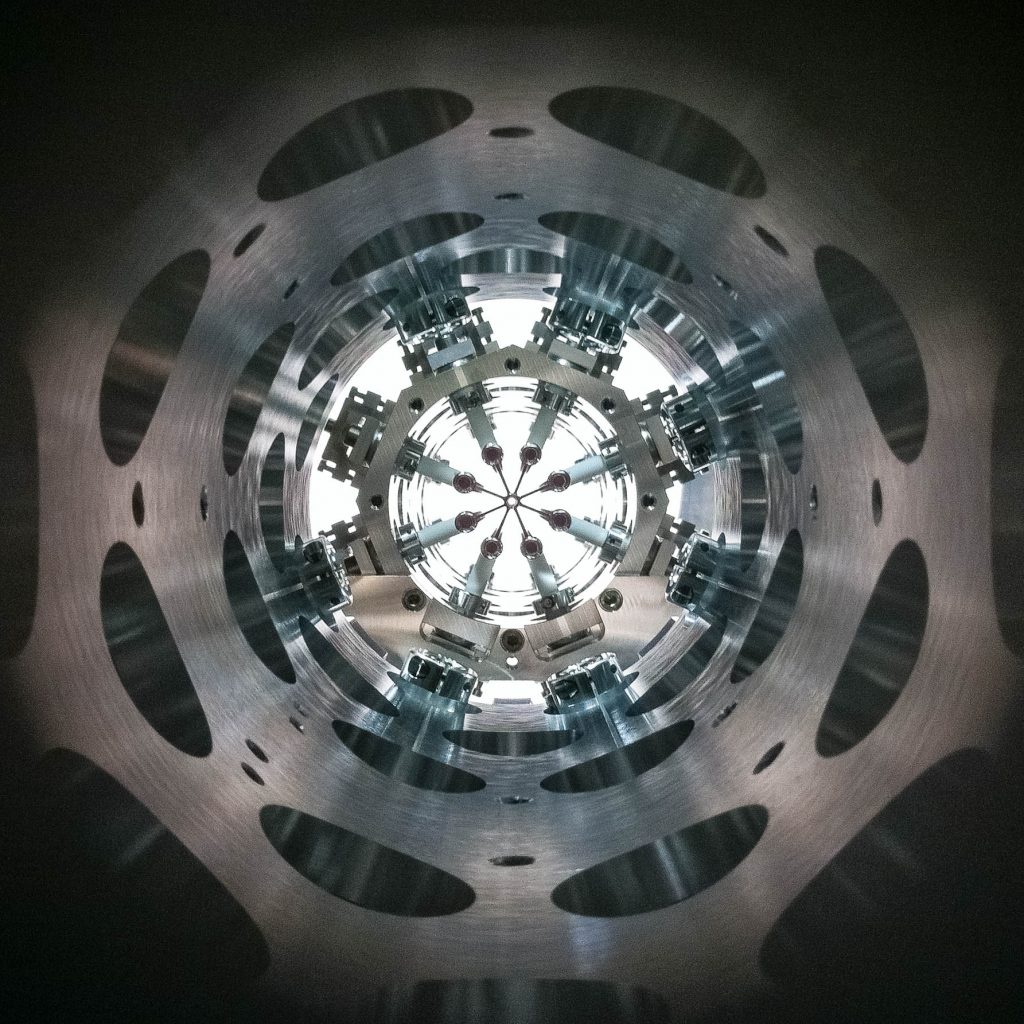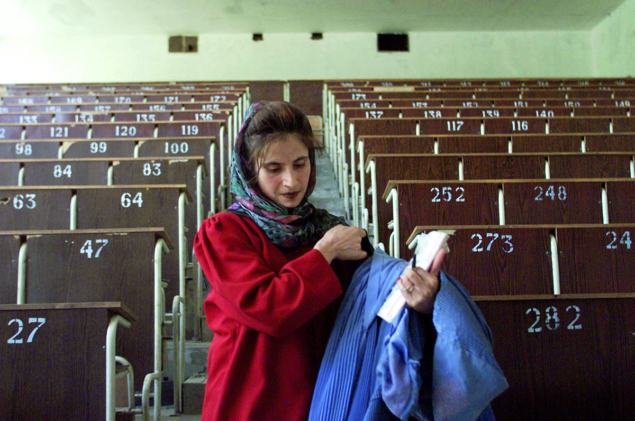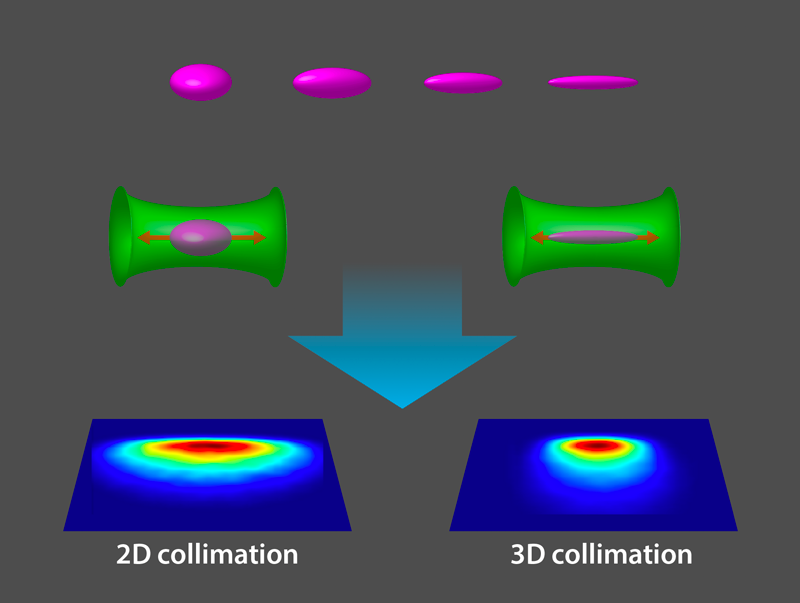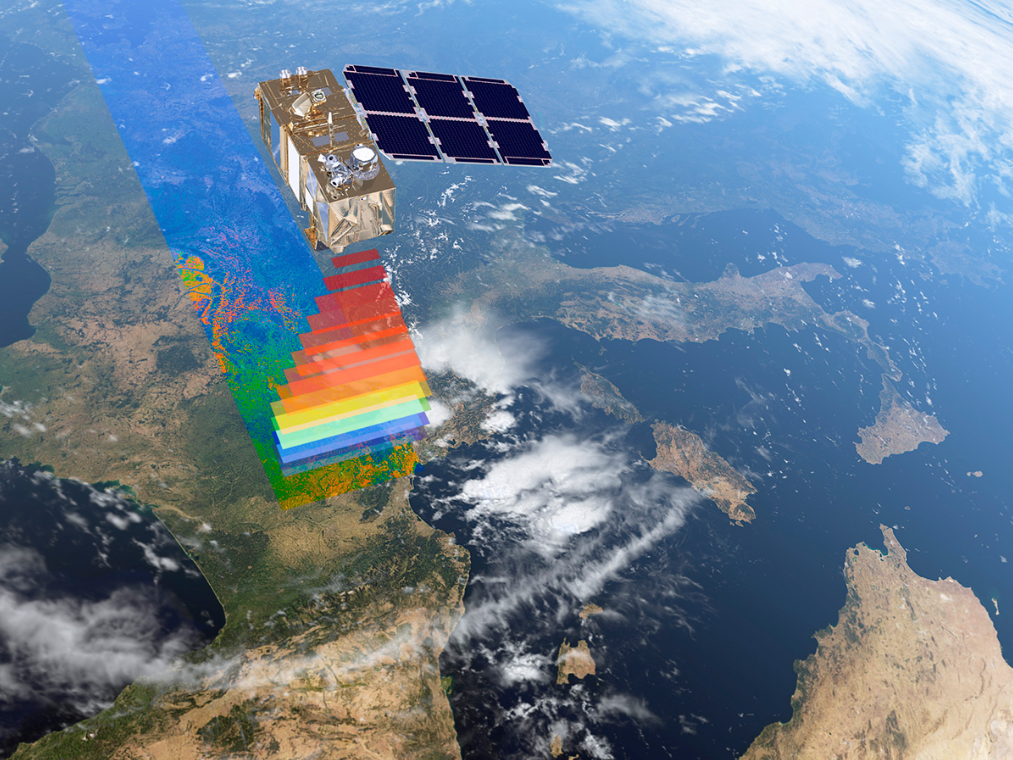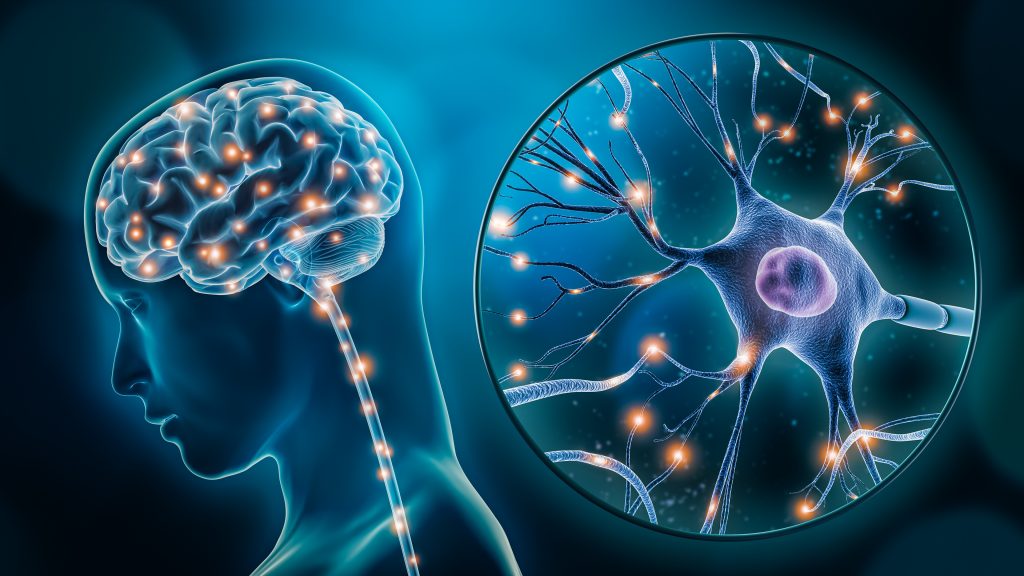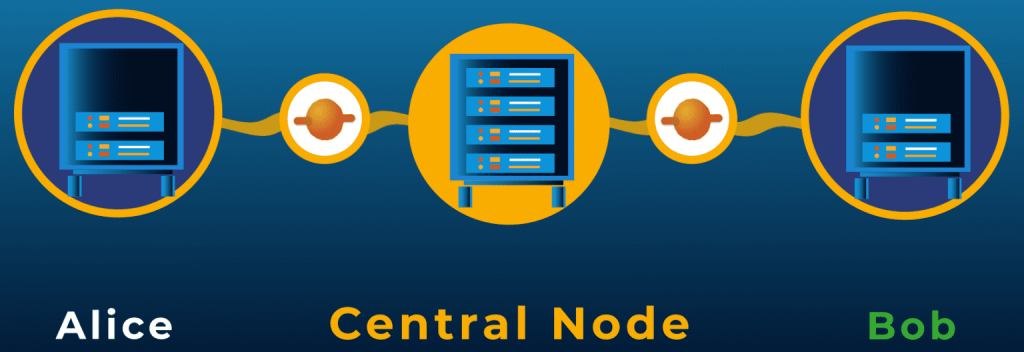There’s only a few days left in the International Year of Quantum Science and Technology, but we’re still finding plenty to celebrate here at Physics World HQ thanks to a long list of groundbreaking work by quantum physicists in 2025. Here are a few of our favourite stories from the past 12 months.
Author:Martijn
Physics World: Atomic system acts like a quantum Newton’s cradle
Atoms in a one-dimensional quantum gas behave like a Newton’s cradle toy, transferring energy from atom to atom without dissipation. Developed by researchers at the TU Wien, Austria, this quantum fluid of ultracold, confined rubidium atoms can be used to simulate more complex solid-state systems. By measuring transport quantities within this “perfect” atomic system, the team hope to obtain a deeper understanding of how transport phenomena and thermodynamics behave at the quantum level.
Physics World: Negative time observed in photon-atom interaction
“Negative time” might sound like science fiction, but an international team of theorists and experimentalists has determined that a photon can, in fact, spend a negative amount of time in an excited atomic state while passing through a cloud of atoms. The finding could have applications in studies of light-matter interactions and quantum sensing – though not, alas, in time travel or other sensational effects.
Physics World: New definition of second ticks closer after international optical-clock comparison
Atomic clocks are crucial to many modern technologies including satellite navigation and telecoms networks, and are also used in fundamental research. The most commonly used clock is based on caesium-133. It uses microwave radiation to excite an electron between two specific hyperfine energy levels in the atom’s ground state. This radiation has a very precise frequency, which is currently used to define the second as the SI unit of time.
Physics World: Large-scale commercial applications of quantum computing remain a distant promise, claims report
Quantum technology is rapidly growing with job demand tripling in the US along with venture capital bringing in billions of dollars into the field. That is according to the inaugural Massachusetts Institute of Technology (MIT) Quantum Index Report 2025, which finds, however, that large-scale commercial applications for quantum computing still remain “far off”.
Physics World: Schrödinger cat states like it hot
Superpositions of quantum states known as Schrödinger cat states can be created in “hot” environments with temperatures up to 1.8 K, say researchers in Austria and Spain. By reducing the restrictions involved in obtaining ultracold temperatures, the work could benefit fields such as quantum computing and quantum sensing.
Chemisch Weekblad: Laser geeft controle op kristalgroei
Marloes Bistervels ontwikkelde een methode om met licht het complexe proces van kristalgroei met ‘micrometerprecisie’ onder controle te houden. Haar promotieonderzoek bij AMOLF opent nieuwe mogelijkheden om functionele biokristallen te maken. ‘Zodra je die sweet spot vindt, kun je de mooiste vormen maken.’
Physics World: Cat qubits open a faster track to fault-tolerant quantum computing
Researchers from the Amazon Web Services (AWS) Center for Quantum Computing have announced what they describe as a “breakthrough” in quantum error correction. Their method uses so-called cat qubits to reduce the total number of qubits required to build a large-scale, fault-tolerant quantum computer, and they claim it could shorten the time required to develop such machines by up to five years.
Nederlands Tijdschrift voor Natuurkunde: Het quantuminternet komt tot leven met een recordverbinding tussen Delft en Den Haag
Een belangrijke mijlpaal voor het toekomstig quantuminternet is gelegd door een internationaal team onder leiding van wetenschappers van het Delftse QuTech. Zij verstrengelden qubits tussen Delft en Den Haag via een bestaande glasvezelverbinding met een recordafstand van 25 kilometer.
Physics World: Quantum science and technology: highlights of 2024
With so much fascinating research going on in quantum science and technology, it’s hard to pick just a handful of highlights. Fun, but hard. Research on entanglement-based imaging and quantum error correction both appear in Physics World’s list of 2024’s top 10 breakthroughs, but beyond that, here are a few other achievements worth remembering as we head into 2025 – the International Year of Quantum Science and Technology.
Physics World: Axion clouds around neutron stars could reveal dark matter origins
Hypothetical particles called axions could form dense clouds around neutron stars – and if they do, they will give off signals that radio telescopes can detect, say researchers in the Netherlands, the UK and the US. Since axions are a possible candidate for the mysterious substance known as dark matter, this finding could bring us closer to understanding it.
Nederlands Tijdschrift voor Natuurkunde: Simulatie van nanobellen geeft inzicht in waterstofproductie
Wetenschappers van de Universiteit Twente presenteren nieuwe inzichten in hoe ongewenste nanobellen zich hechten en groeien aan een elektrodeoppervlak en daarmee de productie van waterstof flink hinderen. Het onderzoek kan helpen om methodes te vinden om deze nanobellen gecontroleerd te verwijderen, wat uiteindelijk kan bijdragen aan een hogere efficiëntie van waterstofproductie.
Physics World: ‘Poor man’s Majoranas’ offer testbed for studying possible qubits
Majorana particles could be an important component in quantum computers – if they exist. Using a new approach, physicists at QuTech in the Netherlands say they have now found fresh hints that Majorana-type behaviour is possible. They have also devised an experimental testbed for studying the properties of these particles and determining whether they live up to expectations.
Physics World: Australia raises eyebrows by splashing A$1bn into US quantum-computing start-up PsiQuantum
The Australian government has controversially announced it will provide A$940m (£500m) for the US-based quantum-startup PsiQuantum. The investment, which comes from the country’s National Quantum Strategy budget, makes PsiQuantum the world’s most funded independent quantum company.
Physics World: Quantum mechanical wormholes fill gaps in black hole entropy
A new theoretical model could solve a 50-year-old puzzle on the entropy of black holes. Developed by physicists in the US, Belgium and Argentina, the model uses the concept of quantum-mechanical wormholes to count the number of quantum microstates within a black hole. The resulting counts agree with predictions made by the so-called Bekenstein-Hawking entropy formula and may lead to a deeper understanding of these extreme astrophysical objects.
Physics World: Europe plans to build 100-qubit quantum computer by 2026
Researchers at the Dutch quantum institute QuTech in Delft have announced plans to build Europe’s first 100-quantum bit (qubit) quantum computer. When complete in 2026, the device will be made publicly available, providing scientists with a tool for quantum calculations and simulations.
Physics World: MEPs call for ‘urgent action’ to implement post-quantum encryption standards
Twenty members of the European Parliament have called for urgent action to develop a new standard for data encryption that would protect against quantum computers being used for malicious purposes. In their letter, the members urge the European Commission to develop security measures and regulations to ward off the threat of quantum computers for cybercrime and data breaches.
Physics World: New ion trapping approach could help quantum computers scale up
Trapping ions with static magnetic and electric fields instead of an oscillating electromagnetic field could make it easier to use ions as building blocks for quantum computers. The new approach, which was developed by researchers at ETH Zurich in Switzerland, allows better control of an ion’s quantum state and position, and marks an important step towards scaling up trapped ions as a platform for quantum computation.
Physics World: Can a classical computer tell if a quantum computer is telling the truth?
Quantum computers can solve problems that would be impossible for classical machines, but this ability comes with a caveat: if a quantum computer gives you an answer, how do you know it’s correct? This is particularly pressing if you do not have direct access to the quantum computer (as in cloud computing), or you don’t trust the person running it. You could, of course, verify the solution with your own quantum processor, but not everyone has one to hand.
Nederlands Tijdschrift voor Natuurkunde: Zwaartekrachtgolf detector LISA gaat met Nederlandse technologie de ruimte in
De Europese Ruimtevaartorganisatie ESA heeft groen licht gegeven voor de lancering van de zwaartekrachtgolfdetector LISA: een uiterst complexe ruimtemissie met een flinke Nederlandse inbreng. LISA moet nieuwe kennis op gaan leveren over onder andere zwarte gaten, de oerknal en donkere materie.
Physics World: Quantum-secure online shopping comes a step closer
Online shopping boomed during the pandemic, but it remains vulnerable to scams involving both buyers and sellers. Quantum communication could, in principle, add another layer of security, but verifying a transaction securely, rather than simply communicating it, requires a “signature” consisting of thousands of quantum bits (qubits) for a single bit of message.
Physics World: Baidu and Alibaba plan to quit quantum computing research
The Chinese search engine company Baidu is giving up its quantum computing division by donating its entire research facility to the government-run Beijing Academy of Quantum Information Sciences (BAQIS). The company says that the two parties are currently in discussion over the details of the donation.
Nederlands Tijdschrift voor Natuurkunde: Pionierend experiment houdt spingolven onder controle
Een baanbrekend experiment bij de TU Delft laat voor het eerst zien dat magnetische golven, spingolven genaamd, door middel van supergeleiders beheersbaar zijn. Spingolven hebben de potentie om elektrische apparatuur efficiënter te maken of om als connectoren in een quantumcomputer te dienen. Het resultaat zet daarmee een flinke stap richting toepassingen van dit natuurkundige fenomeen.
Physics World: Entangled molecules make a novel qubit platform
Ultracold molecules are a step closer to being a viable platform for quantum technology thanks to two independent teams of researchers who showed they could entangle pairs of molecules and encode them as quantum bits (qubits). Because molecules offer new ways to encode quantum information and can interact with each other over long distances, the two works offer new possibilities in quantum computing and quantum simulations beyond those provided by other types of qubits.
Physics World: Quantum science and technology: highlights of 2023
Each year Physics World published the highlights in quantum science and technology and also this year Cool Science featured with 3 articles in the highlights of 2023.
Physics World: Quantum simulator visualizes large-scale entanglement in materials
Physicists in Austria have found a quick and efficient way of extracting information on a quantum material’s large-scale entanglement structure thanks to a 50-year-old theorem from quantum field theory. The new method could open doors in fields such as quantum information, quantum chemistry or even high-energy physics.
Physics World: Physics World reveals its top 10 Breakthroughs of the Year for 2023
Physics World is delighted to announce its top 10 Breakthroughs of the Year for 2023, which ranges from research in astronomy and medical physics to quantum science, atomic physics and more. And also this year one article of Cool Science is picked to be amongst the top 10!
Physics World: Quantum entanglement observed in top quarks
Physicists working on the ATLAS experiment at CERN have observed entanglement between pairs of top quarks for the first time. The finding demonstrates that entanglement can occur at energies more than 12 orders of magnitude higher than is typical for laboratory entanglement experiments. They also show that particle-physics facilities such as CERN’s Large Hadron Collider (LHC) can be used to study quantum mechanics and quantum information.
Physics World: Scalable quantum processor simulates non-equilibrium phase transitions
A 20-qubit quantum processor has been used to simulate the classical and quantum nature of non-equilibrium phase transitions. The work was done by researchers in the US and Canada, who used a processor made by Quantinuum, which is based in the UK and US. The team’s success suggests that small-scale quantum processors could soon be solving some problems that are beyond the capability of conventional computers – an achievement called quantum advantage. This advantage could be put to use in fields including condensed matter, quantum optics and metrology.
Physics World: Quantum superchemistry emerges in the laboratory
Chemical reactions are like a dance between atoms and molecules. As the dancers bounce into each other, they may react to form new combinations, or they may not. The whole process is incredibly complex and unpredictable, with many possible outcomes.
Physics World: Quantum mechanics and thermodynamics can both be true, say physicists
Physicists in the Netherlands and Germany have shown that the theories of thermodynamics and quantum mechanics are both valid ways of describing the behaviour of photons in a quantum processor. The results, obtained by researchers at the University of Twente and the Freie Universität Berlin, open the door to a deeper understanding of how to reconcile these two great theories.
Physics World: IBM’s 127-qubit processor shows quantum advantage without error correction
A 127-qubit quantum processor has been used by an international team of researchers to calculate the magnetic properties of a model 2D material. They found that their IBM quantum computer could perform a calculation that a conventional computer simply cannot, thereby showing that their processor offers quantum advantage over today’s systems – at least for this particular application. What is more, the result was achieved without the need for quantum error correction.
Physics World: Intel releases 12-qubit silicon quantum chip to the quantum community
Intel – the world’s biggest computer-chip maker – has released its newest quantum chip and has begun shipping it to quantum scientists and engineers to use in their research. Dubbed Tunnel Falls, the chip contains a 12-qubit array and is based on silicon spin-qubit technology.
Physics World: Quantum repeater transmits entanglement over 50 kilometres
Physicists at the Universities of Innsbruck in Austria and Paris-Saclay in France have combined all the key functionalities of a long-distance quantum network into a single system for the first time. In a proof-of-principle experiment, they used this system to transfer quantum information via a so-called repeater node over a distance of 50 kilometres – far enough to indicate that the building blocks of practical, large-scale quantum networks may soon be within reach.
Physics World: Sony announces venture into quantum computing via UK firm Quantum Motion
The Japanese electronics giant Sony has announced its first steps into quantum computing by joining other investment groups in a £42m venture in the UK quantum computing firm Quantum Motion. The move by the investment arm of Sony aims to boost the company’s expertise in silicon quantum chip development as well as to assist in a potential quantum computer roll-out onto the Japanese market.
Physics World: Australia sets out A$1bn national quantum strategy
Australia has launched its first national quantum strategy with the aim of becoming a global player in quantum technologies by the end of the decade. Released by the Department of Industry, Science and Resources, the A$1bn initiative aims to boost Australia’s economy, protect the country’s national security and prevent a brain drain of top people heading abroad.
Physics World: Germany reveals €3bn plan to build a quantum computer by 2026
The German government says it will spend €3bn over the next three years to build a universal quantum computer. The project is part of a new initiative to make Germany competitive with countries that have already built or are taking steps to construct such a device. It is hoped the cash will boost the German economy and place the country at the top of quantum developments in the European Union.
Physics World: Physicists want to build a next generation atom interferometer at CERN
The CERN particle-physics laboratory near Geneva could be an ideal location for a next-generation atom interferometer. That is according to an international collaboration of researchers who say that the experiment could be used to study gravitational waves as well as search for ultra-light dark-matter particles.
Physics World: Breakthrough in quantum error correction could lead to large scale quantum computers
Researchers at Google Quantum AI have made an important breakthrough in the development of quantum error correction, a technique that is considered essential for building large scale quantum computers that can solve practical problems. The team showed that computational error rates can be reduced by increasing the number of quantum bits (qubits) used to perform quantum error correction. This result is an important step towards creating fault tolerant quantum computers.
Physics World: Interactions between ultracold molecules controlled by physicists
A way of colliding ultracold molecules while controlling the rate at which they react has been developed by physicists at the Massachusetts Institute of Technology (MIT) in the US. Researchers at Germany’s Max Planck Institute for Quantum Optics have made a similar discovery using an different experimental technique. Their research opens new pathways for enhanced control of chemical reactions.
Physics World: Europe is at the forefront of quantum-based technologies, says report
Europe is leading the race to implement quantum-based technologies, according to a new report from the European Commission. The report examines the state of the 10-year €1bn Quantum Technologies Flagship programme, which began in 2018. It aims to boost quantum research in Europe as well foster the implementation of quantum technologies such as quantum sensing, communication and computation.
Nederlands Tijdschrift voor Natuurkunde: De James Webbruimtetelescoop ontrafelt de chemie in de atmosfeer van exoplaneet WASP-39b
Een internationaal team van astronomen laat met hun early release science-data zien waar de James Webb-ruimtetelescoop toe in staat is. Zij brachten voor het eerst de chemische samenstelling van de atmosfeer van een exoplaneet zeer duidelijk in kaart. De kennis die sterrenkundigen hebben verkregen door onderzoek te doen naar de atmosfeer zal in de toekomst kunnen helpen om te zoeken naar eventueel leven op andere rotsachtige planeten.
Physics World: Telescope with large aperture metalens images the Moon
An important step towards the practical use of optical metasurfaces has been taken by researchers in the US. The team used a common semiconductor manufacturing process to produce a large aperture, flat metalens. Its optical performance was demonstrated by using it as the objective lens in a simple telescope that was aimed at the Moon. The telescope achieved superior resolving power and produced clear images of the surface of the Moon.
Physics World: Quantum science and technology: our favourite research in 2022
Physics World revealed their top 10 favourite research in quantum science and technology in 2022. And this included six articles of Cool Science Blog!
Physics World reveals its top 10 Breakthroughs of the Year for 2022
Physics World revealed its top 10 breakthroughs of the year 2022 and this includes two articles written by Cool Science Blog! The breakthroughs for a new era in ultracold chemistry, that now allows more complex molecules to be created. This type of research can be used to study ultracold reactions, for quantum simulations or to test fundamental physics.
Nederlands Tijdschrift voor Natuurkunde: Nieuw onderzoek brengt Aarde-Maansysteem van 2,5 miljard jaar geleden aan het licht
Onze Maan is het enige hemellichaam dat in baantjes rond de Aarde draait. Maar de Maan draait ook steeds verder van ons weg, wat betekent dat ze miljarden jaren geleden een stuk dichter bij de Aarde stond. Hoeveel dichterbij, dat was tot nu toe moeilijk vast te stellen. Nieuw onderzoek gaat een miljard jaar verder terug dan voorgaand onderzoek en laat ons de toestand en evolutie van het vroegere AardeMaansysteem zien.
Physics World: Quantum teleportation opens a wormhole in spacetime
The equivalent to a wormhole in spacetime has been created on a quantum processor. Researchers in the US used an advanced quantum teleportation protocol to open the wormhole and send quantum signals through it. By studying the dynamics of the transmitted quantum information, the team gained insights into gravitational dynamics. The experiment could be further developed to explore quantum gravity or string theory.
Physics World: UK firm Universal Quantum wins major quantum computing contract
A British quantum start-up firm has been awarded one of the largest government quantum-computing contracts ever given to a single company. Universal Quantum has won the €67m contract from the German Aerospace Center (DLR) to build fully scalable quantum computers based on trapped-ion technology.
Physics World: Report calls on the UK to show ambition in the development of quantum technologies
The UK government must be bold and ambitious to position the country as a world leader in the global quantum technologies market. So says a new report released last month by the Institute of Physics (IOP), which also calls for quantum start-up firms in the UK to be supported to allow research institutes to spin out quantum businesses more easily.
Physics World: Double dose of quantum weirdness pushes sensors past the limit
For most people, quantum mechanics seems pretty weird. Take the principle of delocalization, which states that a quantum particle can, in some sense, exist simultaneously in multiple locations. Then there’s entanglement: the invisible connection between particles that allows the state of one particle to determine that of another, even across vast distances. But as weird as delocalization and entanglement are, they can be very useful, and physicists at JILA in Boulder, Colorado, US have now incorporated both into a single quantum sensor for the first time. The new sensor can detect accelerations below the usual limit set by noise arising from quantum fluctuations, providing a sharper tool for exploring fundamental physics as well as for applications such as navigation and Earth monitoring.
Physics World: Six qubit silicon quantum processor sets a record
A team of researchers in the Netherlands has placed a record number of silicon spin qubits on a chip. By combining an advanced modular software stack, efficient calibration routines and reliable device fabrication, the researchers showed that they could operate the new six-qubit chip with high fidelity, clearing the way for even larger qubit numbers in silicon-based devices.
Nederlands Tijdschrift voor Natuurkunde: Aanstaande industriële nanorevolutie dankzij nanoturbines van DNA
Onderzoekers van de Technische Universiteit Delft hebben voor het eerst een intrinsiek gedreven nanoturbine ontwikkeld, die in groot contrast staat met de huidige extern aangedreven nanomotoren. Ze gebruiken hiervoor een zelforganiserend proces van DNA dat zich ontvouwt tot een propellor die in de vloeistofstroming van een nano-porie roteert en daarmee arbeid verricht. Deze ontdekking is een
enorme stap vooruit voor synthetische nanomotoren die bijvoorbeeld gebruikt kunnen worden voor robotica op de nanoschaal.
Nederlands Tijdschrift voor Natuurkunde: De continue-atoomlaser eindelijk in zicht dankzij ‘oneindig’ Bose-Einstein-condensaat
Onderzoekers van de Universiteit van Amsterdam hebben voor het eerst de basis van een continu-atoomlaser gelegd. Dit type lasers kan voor een doorbraak zorgen in ultra-precisiemetingen en kan bijvoorbeeld worden gebruikt voor metingen aan zwaartekrachtgolven of voor het vinden van donkere energie en materie.
Physics World: Quantum computing gets down to business
Martijn Boerkamp reports how investments into quantum computing have ballooned in the past year, bringing huge expectations for the sector.
Physics World: Device independent QKD brings unhackable quantum internet closer
Two independent research groups have demonstrated a protocol for distributing quantum-encrypted keys via a method that is sure to leave would-be network hackers in the dark. The protocol, dubbed device independent quantum key distribution, was first proposed three decades ago but had not been realized experimentally before due to technical limitations, which the researchers have now overcome.
Physics World podcast: Quantum communication for alien civilizations
Physics World’s Margaret Harris explains how alien civilizations could be using quantum signals to communicate with us on Earth. This topic is taken from my earlier Physics World article.
Physics World: NIST selects four post-quantum encryption standards
The US National Institute of Standards and Technology (NIST) has selected four algorithms that will be developed as post-quantum encryption standards to protect data from a future quantum computer attack. The announcement follows a six-year competition, with NIST now calling on institutions to investigate how to best apply the standards.
Physics World: Aliens could use quantum signals to communicate with Earth
The Search for Extraterrestrial Intelligence (SETI) might want to add quantum communication to its list of ways for aliens to get in touch. According to calculations by researchers at the University of Edinburgh in the UK, quantum signals would be a viable means of establishing contact across interstellar distances – a result that also suggests we might need to update our technology to recognize any such signals coming in our direction.
Nederlands Tijdschrift voor Natuurkunde: Van chaos tot orde in de wetenschap van zeespiegelprojecties
De zeespiegel gaat stijgen, dat staat vast. Onderzoek naar klimaatverandering laat zien dat we de komende decennia een onvermijdelijke stijging in zeewaterniveau kunnen verwachten. Maar hoe groot de verwachte stijging is, hangt af van het type model dat gebruikt wordt voor de voorspelling, waarbij soms een zelfde set van data verschillende conclusies geeft. Dit is niets nieuws in de wetenschap, aangezien de complexiteit van grootschalige systemen, zoals het klimaat, zich niet makkelijk laat modelleren. Maar het maakt het er niet makkelijker op voor de beleidsmakers die ervoor moeten zorgen dat we goed voorbereid zijn, want je kunt je beslissing niet elke keer aanpassen als er een nieuwe publicatie uitkomt.
Physics World: Laser cooling of polyatomic molecules brings ultracold chemistry into the spotlight
Physicists in the US have created ultracold polyatomic molecules by trapping and cooling them directly in three dimensions. Led by John Doyle at Harvard University, the team used a standard device known as a magneto-optical trap (MOT), plus additional laser cooling techniques, to reduce the temperature of a sample of calcium hydroxide (CaOH) molecules to just 110 µK. By showing that direct laser cooling is possible, the result opens the door to experiments in molecule-based quantum simulation and studies of chemical reactions involving polyatomic molecules.
Physics World: Quantum teleportation expands beyond neighbouring nodes
Physicists in the Netherlands have shown for the first time that quantum information can be reliably teleported between network nodes that are not directly connected to each other. According to the researchers, who created the world’s first three-node quantum network at QuTech (a collaboration between the Delft University of Technology and TNO) in 2021, the latest work marks a further step towards a scalable quantum Internet.
Physics World: Netherlands invests E1.1bn in the photonic chip industry
The Dutch photonic chip industry has been boosted with €1.1bn of public and private investment. The cash, which includes €470m from the Dutch government’s National Growth Fund, will be used by PhotonDelta over six years to create hundreds of photonic start-up companies and scale up photonic-chip production to encourage development of new photonic applications.
Physics World: Quantum Error Correction makes its zero magnetic field debut
Researchers in Japan have developed a way of correcting errors in quantum operations without applying a magnetic field. The new zero-field technique, which they demonstrated using quantum bits (qubits) constructed from atomic-scale imperfections in diamond, could make it possible to integrate such qubits with others based on superconducting circuits, and thereby construct larger and more powerful quantum devices.
Link Magazine: Bouwstenen voor quantumcomputers klaar voor massaproductie
Onderzoekers van QuTech (een samenwerking van TNO en TU Delft) en Intel hebben voor het eerst de bouwstenen van een quantumcomputer, genaamd qubits, gemaakt met dezelfde industriële productiefaciliteiten waarmee ook conventionele computerchips in massa worden geproduceerd. Hun resultaten zijn gepubliceerd in het wetenschappelijke tijdschrift Nature Electronics.
Inside Quantum Technology: How Dutch ecosystems help the progress of quantum technology
“Many hands make light work”. It’s an expression that is embedded in Dutch culture. And this is not different when it comes to quantum technology developments in the Netherlands. With only a population of 17 million people, the country is ranked third for scientific citations in quantum research and has the highest number of quantum based startups per capita in the world. This is a bit surprising, as it’s lacking big research funding or VC investments as those found in other countries, such as the US. However, strategic funding, such as the National Growth Fund that aims to boost the Dutch economy, can still make an impact. Because when making ideal use of the country’s small size, one can use its infrastructure for setting up a quantum ecosystem.
Physics World: Silicon spin qubits manufactured on an industrial scale
Researchers in the Netherlands and the US have shown for the first time that qubits – the building blocks of quantum computers – can be mass-produced using standard processes developed for manufacturing conventional integrated circuits. The breakthrough paves the way for developing powerful quantum machines that require thousands or even millions of identical qubits for full-scale operation.
Physics World: Fast electrons accelerate the production of medical isotopes
A new method for producing medical radioisotopes has passed its first milestone, by exposing a target to an electron beam at energy densities several orders of magnitude higher than found at the core of the Sun. This achievement paves the way for alternative radioisotope production methods using electron accelerators that do not require enriched uranium and produce little nuclear waste.
Physics World: Time crystals on a quantum computer reach a record size
Researchers in Australia have created the largest time crystal to date, using 57 qubits on an openly accessible IBM quantum computer to construct an exotic phase of matter with properties that repeat over time, rather than in space. The result emphasizes the utility of quantum computers for simulating complex quantum systems and marks an important step towards creating even larger systems of time crystals.
Physics World: New Dutch childcare programme to support ‘quantum mothers’
Two Dutch organizations have teamed up to announce a programme to help new mothers continue working in quantum technologies. The Quantum Childcare Pilot Programme is funded by the Dutch organization Quantum Delta NL and the professional body Women in Quantum Development (WIQD) and is aimed at women working in quantum-related fields in the Netherlands. It will offer grants to help parents find childcare so they can attend quantum-related events and conferences.
Physics World: Engineered disorder makes ultrathin solar cells ultra efficient
Ultrathin solar cells have reached record-breaking efficiency thanks to a novel manufacturing method that introduces specific types of disorder within the cells’ nanocrystalline structure. The low cost, reduced mass and non-toxic nature of this type of cell makes them ideal for integration into cars, rooftops or mobile devices, and the newly streamlined way of manufacturing them paves the way for their large-scale production.
Physics World: Ultracold triatomic molecules herald a new frontier for the three body problem
Researchers in China have found strong evidence of ultracold triatomic molecules forming within a mixture of ultracold atoms and diatomic molecules. The result, if confirmed, would provide an ideal pathway to studying chemical reactions on an atomic scale, and could even allow physicists to perform quantum-mechanical simulations of the notoriously difficult three-body problem.
Bits & Chips: Inphocal has its focus on the laser processing market
With its optical system, Inphocal can take focused laser beams beyond their current limitations. This has caught international attention, with the team picking up an Innovation Award at the Consumer Electronics Show in Las Vegas. The HightechXL startup expects the novel laser beams to reach the market already this year.
Physics World: Physicist Robbert Dijkgraaf appointed science minister
Dutch physicist Robbert Dijkgraaf, 62, has been appointed education, culture and science minister in the newly formed Dutch cabinet led by Mark Rutte, who began his fourth term as prime minister last month.
Physics World: Quantum entanglement boosts accuracy of industrial quality inspections
Industrial manufacturing is subject to stringent testing protocols aimed at guaranteeing the quality of the final product. In some circumstances, though, these methods are not sensitive enough to detect flaws, leading to incorrect determinations of quality. Researchers at the Istituto Nazionale di Ricerca Metrologica (INRiM) in Torino, Italy have now shown that alternatives based on quantum entanglement can produce more accurate assessments of “good” and “failed” products. Importantly, the INRiM team’s system uses relatively simple equipment, increasing the chances that it could be used in industrial settings.
Physics World: Frequency upconversion makes infrared light visible
A new way of converting infrared light into visible wavelengths could make it possible to detect and measure mid-infrared signals using cheap and efficient sensors like those found in mobile-phone cameras. The method, which was developed independently by two teams of researchers, could have applications in areas as diverse as personalized medicine, environmental monitoring and security.
Physics World 2021 Highlights in Quantum Science Technology
Physics World has mentioned two articles of Cool Science Blog in this year’s highlights in Quantum Science Technology! This year has seen many highlights in Quantum Science and many appear on this blog. It’s great to get the recognition by Physics World 😎
Physics World: Atomically thin lasers shine for the first time at room temperature
A two-dimensional semiconductor crystal just three atomic layers thick has emitted laser-like light. Crucially, this emission happened at room temperature: a significant improvement over previous cryogenic experiments. Coherent light generation from these ultrathin crystals paves the way for creating novel nanolasers, as well as opening doors for an emerging field of two-dimensional materials called valleytronics.
Physics World: A quantum promise
Freeke Heijman from Quantum Delta NL tells Martijn Boerkamp how the
Netherlands is forging ahead in quantum technologies
Physics World: QuTech launches a browser for the quantum Internet
The event I attended on Friday caught my attention for several reasons. Billed as the Quantum Network Explorer (QNE) Launch, it took place in the Hague, the Netherlands, not far from where I live. In a year that has seen so much exciting progress on quantum networks, I was curious to find out what it involved. But I was also drawn by the event’s name, which made it sound a lot like Microsoft’s all-but-defunct web browser, Internet Explorer.
Physics World: Physicists create discrete time crystals in a programmable quantum simulator
Time crystals are special quantum systems that exhibit periodicity in time, just as crystalline materials are periodic in space. Since 2012, when they were first proposed theoretically, several groups have built experimental systems that demonstrate key characteristics of time crystals, but these results lacked a method to generally stabilize the time crystalline phase. An international team of researchers has now gone beyond previous experiments by creating a type of time crystal known as a discrete time crystal (DTC) out of a chain of programmable spin quantum bits (qubits). The new system exhibits a phenomenon known as many-body localization that prevents the DTC from heating up and thermalizing and is considered a “smoking gun” that demonstrates its status as a genuine time crystal.
Physics World: Laser-free trapping of heavy molecules opens an alternative route to new physics
The quest for physics outside the Standard Model often takes place at major accelerator facilities like CERN’s Large Hadron Collider or huge underground detectors for neutrinos, dark matter and other exotic particles. Researchers in the Netherlands have now opened an alternative front in this quest by developing a new laboratory-scale technique for trapping heavy neutral molecules. Such molecules are considered ideal candidates for detecting beyond-the-Standard-Model asymmetries in the electron’s electric dipole moment (eEDM), but previous methods were not capable of confining them. The technique therefore gives physicists a fresh set of tools for finding new physics.
Nobelprijs voor de Natuurkunde 2021 uitgelegd
De Nobelprijs voor Natuurkunde ging dit jaar naar drie natuurkundigen. Syukuro Manabe en Klaus Hasselmann ontvingen hun prijs voor “de fysieke modellering van het klimaat op aarde, het kwantificeren van variabiliteit en het betrouwbaar voorspellen van de opwarming van de aarde”. De derde natuurkundige Giorgio Parisi ontving zijn prijs voor “de ontdekking van het samenspel van wanorde en fluctuaties in fysieke systemen van atomaire naar planetaire schalen.” Dit is de officiële verklaring van het Nobelprijscomité. Het is veel informatie in een paar kleine zinnen en daardoor is het misschien een beetje moeilijk te begrijpen. Dus laat me proberen dit uit te leggen in wat gemakkelijker te begrijpen taal.
Physics Nobel prize 2021 explained
This year’s Physics Nobel prize went to three physicists. Syukuro Manabe and Klaus Hasselmann received their prize for “the physical modelling of Earth’s climate, quantifying variability and reliably predicting global warming”. The third physicist Giorgio Parisi received his prize for “the discovery of the interplay of disorder and fluctuations in physical systems from atomic to planetary scales.” This is the official explanation of the Nobel prize committee. It is a lot of information in a few small sentences and with that, it might be a bit difficult to understand. So let me try to explain this in some easier to understand language.
Physics World: Afghan scientists fear for the future in war-torn country
Calls have been made to help scientists in Afghanistan after the country was plunged into chaos in August when the Taliban regime took power in the war-torn country. Universities and other educational institutions have already closed their doors and science education has ground to a halt. Some scientists have even fled abroad, believing themselves direct targets of the Taliban.
Physics World: Bose-Einstein condensates hit record low temperature
A new way of controlling the expansion of matter in a freely-falling Bose-Einstein condensate (BEC)has produced the coldest effective temperature ever measured: 38 pK (10 K) above absolute zero. The method, which allowed researchers in Germany and France to image the condensate’s evolution for more than two seconds, opens the door to enhanced measurements of the gravitational constant g and photon recoil, and could even offer an alternative mea
Delftse Post: Een ruimtereis naar de sterren
Een reis naar een andere ster in ons universum maak je niet zomaar, want je bent misschien wel honderden jaren onderweg. Daarom denken onderzoekers aan de TU Delft alvast na hoe je een ruimteschip tijdens de reis kan laten evolueren, om zodoende de lange reis te kunnen overbruggen.
Delftse Post: Geen lawaai met geluidloze vliegtuigen
Vliegtuigen geven een karakteristiek geluid af, wat zeer storend kan zijn voor mensen die dichtbij een vliegveld wonen. Nieuw onderzoek naar de akoestiek van vliegtuigen laat zien hoe dit type lawaai verholpen wordt, waardoor vliegtuigen net zo geruisloos als uilen door de lucht kunnen zweven.
Physics World: European Union unveils new €7.5bn space deal
The European Space Agency (ESA) has unveiled a new space programme following a €7.5bn partnership deal with the European Union (EU). The investment, running from 2021 to 2027, accounts for approximately 20% of ESA’s total budget and will be spent designing new-generation navigation systems and programmes to boost the economy and provide a green and digital Europe. It will also support new initiatives in security and space commercialization, and offer new funding opportunities for entrepreneurship.
Delftse Post: Knippen en plakken met DNA
Wetenschappers aan de TU Delft gebruiken een revolutionaire technologie om in DNA te knippen. Virussen maak je daarmee onschadelijk of kunnen juist worden geherprogrammeerd, om ons lichaam te laten herstellen van een ziekte.
Technisch Weekblad: Een Nederlandse robot naar de maan
Afgelopen mei werd het officieel: een samenwerking tussen de TU Delft en TNO die als doel heeft om een Nederlandse robot naar de maan te sturen. De ontwikkeling van deze ‘Lunar Zebro’ robots is een inspirerend project, grotendeels uitgevoerd door studenten. Als het lukt is het een sterk staaltje technologie, met een flinke dosis Nederlandse trots. Staat er binnenkort een Nederlandse vlag op de maan?
Delftse Post: AI: de technologie van de toekomst
We laten tegenwoordig veel van ons werk door robots uitvoeren, bijvoorbeeld in zelfrijdende auto’s. Maar het zijn niet alleen de fysieke taken die robots uitvoeren: ze kunnen ook over complexe dingen nadenken, zoals een mens dat nooit zou kunnen. De TU Delft is al bezig met deze toekomst en zet groots in op onderzoek en onderwijs rondom dit thema.
Delftse Post: Mini-drones detecteren gaslekken
Een gaslek kan nare gevolgen hebben. En het vinden van een gaslek kan veel tijd kosten, wat het extra gevaarlijk maakt voor de brandweerlieden die deze taak uitvoeren. Een nieuwe technologie, waarbij mini-drones worden ingezet om een gaslek op te sporen, kan veilig en snel het probleem oplossen.
Delftse Post: Het complexe netwerk in onze hersenen
Ons brein bevat miljarden neuronen, die nauwgezet samenwerken om ons te laten doen en denken. Zoveel neuronen, en biljoenen aan neuronale contacten, maakt dit tot een complex geheel. TU Delft onderzoekers proberen ons brein beter te begrijpen. Dit kan uiteindelijk zelfs leiden tot een betere behandeling van, bijvoorbeeld, Alzheimer.
Delftse Post: Demonstratie van onkraakbaar internet
Een wereldwijde primeur werd afgelopen week door het Delftse QuTech, samen met Quantum Delta NL, KPN en Cisco, gepresenteerd. Het ging om de allereerste demonstratie van een onkraakbaar quantum-internet.
Physics World: Is the quantum internet finally here?
If you’ve ever attended the premiere of a film or an event where a new type of car is presented, you’ll know that there’s a slight buzz of excitement that comes from not knowing what to expect. I’ve been feeling that buzz for the past two weeks, leading up to an event that promised a “world premiere live demonstration of the next step in quantum cryptography”. It was not that the whole event was clouded in mystery, as some small teasers were released leading up to it. Still, with all the recent developments on the quantum Internet, I was left wondering: what exactly is the “state of the art” they plan to demonstrate?
Delftse Post: Nanodeeltjes bestrijden borstkanker
Een nieuwe methode, waarbij nanodeeltjes direct in een tumor worden gespoten, moet gaan zorgen voor een meer effectieve behandeling tegen borstkanker. Deze eenmalige behandeling zal minder schadelijk zijn dan, bijvoorbeeld radio- of chemotherapie, en is daarmee minder zwaar voor de patiënt.
Delftse Post: De mysterieuze planeet Venus
De Europese ruimtevaartorganisatie (ESA) stuurt, met een beetje hulp vanuit Delft, een ruimtevaartuig genaamd EnVision met gevoelige meetapparatuur naar onze buurplaneet Venus. Door Venus te bestuderen kunnen we meer te weten komen over onze eigen klimaatverandering.
Delftse Post: Koude chips voor quantumcomputers
Onderzoekers van QuTech en Intel hebben samen een chip ontwikkeld die helpt een belangrijk probleem binnen de ontwikkeling van een quantumcomputer op te lossen. Deze chip wordt tot extreem koude temperaturen gekoeld en kan, op dezelfde manier als bij een normale computer, een quantumcomputer aansturen.
Delftse Post: TU Delft en TNO gaan samen naar de maan
Een nieuwe samenwerking, tussen het TU Delft team ‘Lunar Zebro’ en TNO, moet leiden tot unieke maanrobots die over enkele jaren over het maanoppervlak lopen. De samenwerking combineert cruciale kennis en kunde en probeert voor het eerst Nederlandse technologie op de maan te zetten.
Bits&Chips: Aircision and TNO raise the bar for high speed, long distance laser communication
Aircision and TNO have completed their test of setting up fast data transmission links between two towers using laser beams. They succeeded in 10 Gb/s data transmission over a distance of 2.5 kilometers, which is considered an important landmark for ground-to-ground laser communication. This ‘fiber-optic-through-the-sky’ technology, named free-space optics, can now make its way into 5G broadband connectivity.


